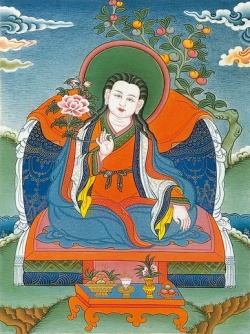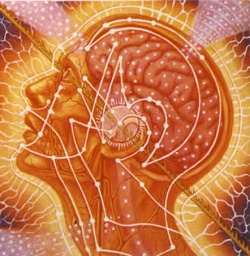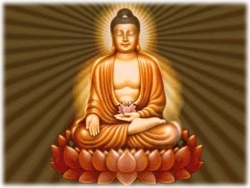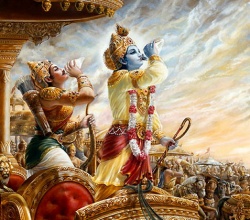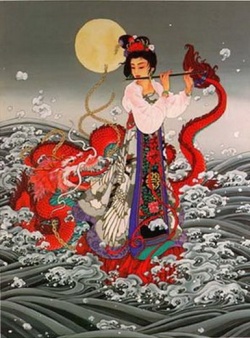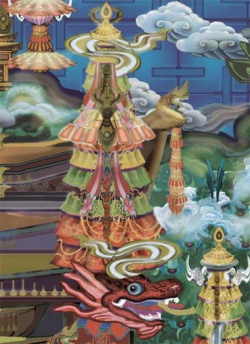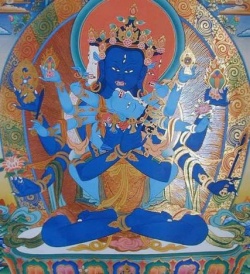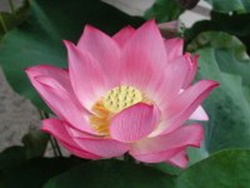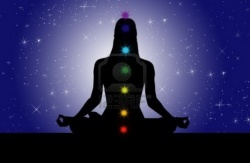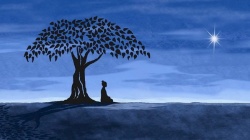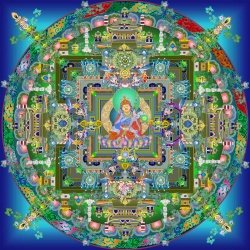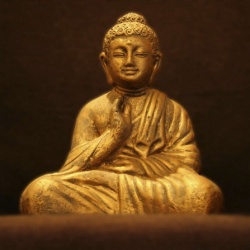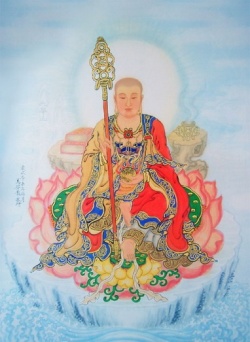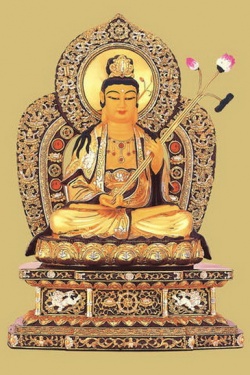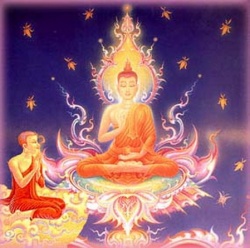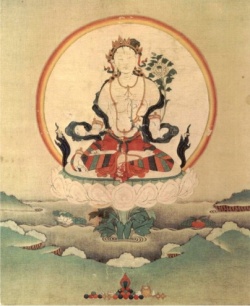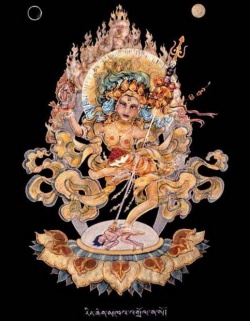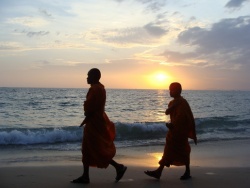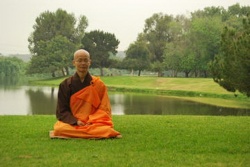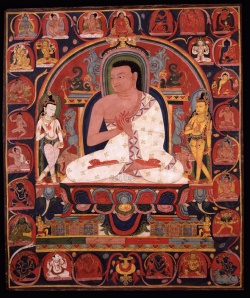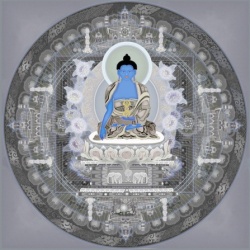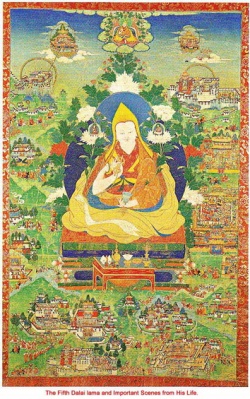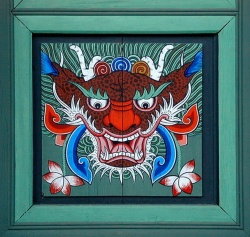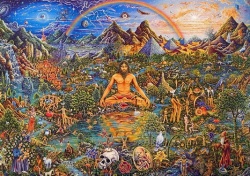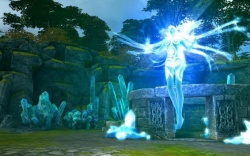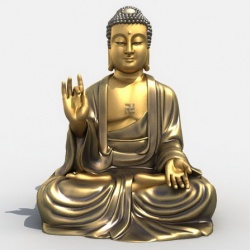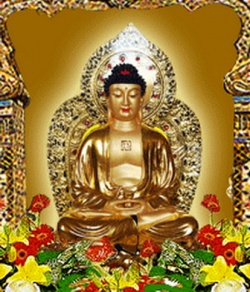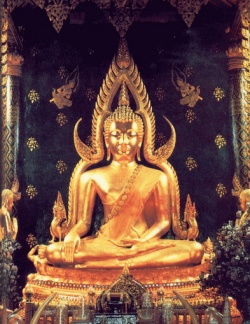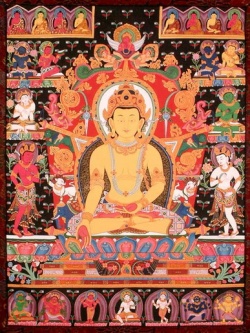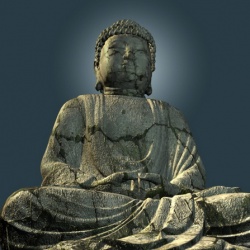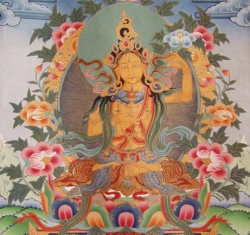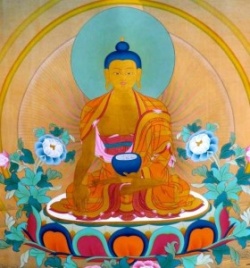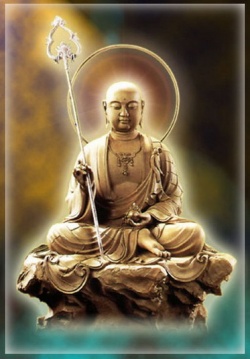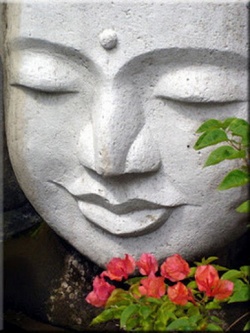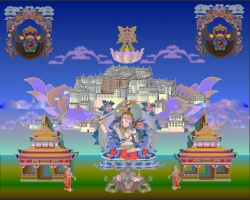Difference between revisions of "Brahmanism, Buddhism, and Hinduism"
| Line 6: | Line 6: | ||
| − | In the essay that follows Dr. Joshi has set out to reply to certain [[Indian]] [[scholars]] who have criticised [[Buddhism]], and others who have put forward the {{Wiki|theory}} that [[Buddhism]] is simply a [[form]] of [[Hinduism]] or an offshoot of it. His {{Wiki|thesis}} broadly falls under five heads, namely: 1. The [[Buddha]] was not “born a [[Hindu]]” because [[Hinduism]] in its present [[form]] had not emerged at the [[time]] of his [[birth]]; 2. Before the [[time]] of the [[Buddha]] the [[religion]] of [[India]] was {{Wiki|Vedic}} | + | In the essay that follows Dr. Joshi has set out to reply to certain [[Indian]] [[scholars]] who have criticised [[Buddhism]], and others who have put forward the {{Wiki|theory}} that [[Buddhism]] is simply a [[form]] of [[Hinduism]] or an offshoot of it. His {{Wiki|thesis}} broadly falls under five heads, namely: 1. The [[Buddha]] was not “born a [[Hindu]]” because [[Hinduism]] in its present [[form]] had not emerged at the [[time]] of his [[birth]]; 2. Before the [[time]] of the [[Buddha]] the [[religion]] of [[India]] was {{Wiki|Vedic}} [[Brahmanism]], but that alongside the {{Wiki|Vedic}} [[tradition]] there was an [[ascetic]] (Œrama.a) stream of [[religious]] [[thought]] and practise having its origin in prehistoric times; 3. That it is to this [[Brahmanic]] {{Wiki|culture}} that [[Buddhism]] has its closest [[affinity]]; 4. That [[Hinduism]] grew out of a fusion of {{Wiki|Vedic}} Brahma.ism with [[Buddhism]] and other Œrama.ic [[religious]] trends; 5. That although [[Buddhism]] acknowledges an [[affinity]] with the Œrama.ic cults, it is nevertheless a unique product of the [[Buddha’s]] direct [[insight]]. Dr. Joshi is not the first to have pointed out the more obvious of these facts; but in his essay he has brought to bear on the [[subject]] an impressive erudition and has supported his arguments with the result of much painstaking research. We believe that few [[people]] will be inclined to question his general conclusions. Dr. Joshi is {{Wiki|Professor}} at the Department of [[Religious]] Studies, {{Wiki|Punjabi}} {{Wiki|University}}, Patiala, [[India]]. At present he is serving the {{Wiki|Harvard University}} as a visiting fellow at the Center for the Study of [[World]] [[Religions]], {{Wiki|Cambridge}}, Mass., {{Wiki|U.S.A}}. Among other writings, he has to his credit a comprehensive and [[scholarly]] work, Studies in the [[Buddhistic]] {{Wiki|Culture}} of [[India]] ({{Wiki|New Delhi}} 1967, {{Wiki|Motilal Banarsidass}}). December 1969 |
[[Buddhist]] Publication {{Wiki|Society}} | [[Buddhist]] Publication {{Wiki|Society}} | ||
| Line 13: | Line 13: | ||
I. Introductory Remarks | I. Introductory Remarks | ||
| − | Much {{Wiki|modern}} {{Wiki|literature}} in English, {{Wiki|French}}, {{Wiki|German}}, {{Wiki|Hindi}} and other [[languages]] has been produced on [[early Buddhism]] and its [[relation]] to Brahma.ism and [[Hinduism]]. It would appear from the apparently settled [[posture]] of {{Wiki|modern}} [[Buddhist]] {{Wiki|scholarship}} that those problems are settled beyond all [[doubt]] and dispute. However, when we reopen these matters with a [[view]] to restating them, we record our disagreement with the current theories of the [[origins of Buddhism]], of its early relations with Brahma.ism and of its position with regard to [[Hinduism]]. In [[India]], where the Brahma.ical or the [[traditional]] standpoint has possessed the {{Wiki|scholastic}} field for about a millennium now, and has been regarded with reverence not only among {{Wiki|modern}} [[Indian]] {{Wiki|historians}} and national leaders but also among {{Wiki|Western}} {{Wiki|Indologists}}, for about a century and a half, it would appear almost an impertinence on our part to put forth a [[view]] which goes against it. However, a student of the history of [[religious]] [[traditions]] of [[India]] will have to rise above artificial conventions set by the writings of others should he find that his suggestions would help a better and clearer [[understanding]] of some significant facts of the growth of his country’s central [[traditions]] as “[[Wikipedia:Heterodoxy|heterodox]].” This {{Wiki|custom}} is due to our preoccupation with the [[traditional]] or Brahma.ical point of [[view]]. From the [[Buddhist]] point of [[view]] Brahma.ism was a “[[heresy]]’; from the | + | Much {{Wiki|modern}} {{Wiki|literature}} in English, {{Wiki|French}}, {{Wiki|German}}, {{Wiki|Hindi}} and other [[languages]] has been produced on [[early Buddhism]] and its [[relation]] to Brahma.ism and [[Hinduism]]. It would appear from the apparently settled [[posture]] of {{Wiki|modern}} [[Buddhist]] {{Wiki|scholarship}} that those problems are settled beyond all [[doubt]] and dispute. However, when we reopen these matters with a [[view]] to restating them, we record our disagreement with the current theories of the [[origins of Buddhism]], of its early relations with Brahma.ism and of its position with regard to [[Hinduism]]. In [[India]], where the Brahma.ical or the [[traditional]] standpoint has possessed the {{Wiki|scholastic}} field for about a millennium now, and has been regarded with reverence not only among {{Wiki|modern}} [[Indian]] {{Wiki|historians}} and national leaders but also among {{Wiki|Western}} {{Wiki|Indologists}}, for about a century and a half, it would appear almost an impertinence on our part to put forth a [[view]] which goes against it. However, a student of the history of [[religious]] [[traditions]] of [[India]] will have to rise above artificial conventions set by the writings of others should he find that his suggestions would help a better and clearer [[understanding]] of some significant facts of the growth of his country’s central [[traditions]] as “[[Wikipedia:Heterodoxy|heterodox]].” This {{Wiki|custom}} is due to our preoccupation with the [[traditional]] or Brahma.ical point of [[view]]. From the [[Buddhist]] point of [[view]] Brahma.ism was a “[[heresy]]’; from the [[Brahmanical]] point of [[view]] [[Buddhism]] was a “[[heresy]].” When Dr. {{Wiki|S. Radhakrishnan}}, broadcasting from {{Wiki|All India Radio}} on the occasion of the 2500th [[Mahaparinirvana]]-day of the [[Buddha]], described [[Buddhism]] as “an offshoot of the more {{Wiki|ancient}} [[faith]] of the [[Hindus]], perhaps a {{Wiki|schism}} or a heresy’1, he not only repeated a particular [[view]] but perhaps also gave an “official” stamp to the Brahma.ical standpoint in [[Indian]] history. It is no {{Wiki|exaggeration}} to say that whatever has been written on the history of [[Buddhism]] in [[India]] has been written in {{Wiki|modern}} times largely from this standpoint. The conflict between [[Buddhism]] and Brahma.ism, the [[transformation]] of the [[Buddhist]] heritage in [[India]] and the [[disappearance]] of [[Buddhism]] as a living [[faith]] from [[Indian]] soil during the early mediaeval centuries were largely responsible for the growth of misconceptions about {{Wiki|Ancient Indian}} {{Wiki|civilization}} and also for the [[propagation]] of the Brahma.ical standpoint during mediaeval through {{Wiki|modern}} times. The future of [[Buddhist studies]] in [[India]] will remain quite [[doubtful]] so long as [[Indian]] [[scholars]] continue to study [[Buddhism]] as a “{{Wiki|heretical}} system” and from the “{{Wiki|orthodox}}” standpoint. [[Buddhism]] should be studied from the [[Buddhist]] standpoint, and its relations with Brahma.ism and [[Hinduism]] should be studied from the historical standpoint and on [[scientific]] lines. The study of [[Buddhism]] from the [[Hindu]] [[view]] would be a study of [[Hinduism]] and not of [[Buddhism]]. It was an [[exceptional]] thing that a noted {{Wiki|British}} antiquarian, Sir Mortimer Wheeler, actively engaged in digging up India’s past, once observed that “it cannot be denied that during the seven centuries between 250 BCE and CE 450 most of the surviving {{Wiki|sculpture}} of the [[highest]] quality in [[India]] was associated with [[Buddhism]], and it was, above all, [[Buddhism]] that during the same period (and particularly the latter part of it) spread [[Indian]] [[art]] and idiom through the highways and byways of {{Wiki|Asia}}. Archaeologically, at least, we cannot treat [[Buddhism]] merely as a |
1 Occasional Speeches and Writings (October 1952–February. 1959) by S. Radhakrishna, Publications Division, {{Wiki|New Delhi}}, 1960, pp. 337–346, p. 323; also 2500 Years of [[Buddhism]] edited by P V. Bapat, Publications Division, Govt. of [[India]], {{Wiki|New Delhi}}, reprint 1959, Foreword, pp. v-xvi. | 1 Occasional Speeches and Writings (October 1952–February. 1959) by S. Radhakrishna, Publications Division, {{Wiki|New Delhi}}, 1960, pp. 337–346, p. 323; also 2500 Years of [[Buddhism]] edited by P V. Bapat, Publications Division, Govt. of [[India]], {{Wiki|New Delhi}}, reprint 1959, Foreword, pp. v-xvi. | ||
| Line 20: | Line 20: | ||
There are about 1200 rock-cut monuments ([[caves]], [[monasteries]]. sanctuaries, [[temples]]) of {{Wiki|ancient India}}; of these 100 belong to [[Jainism]], 200 to Brahma.ism and the remaining to [[Buddhism]]. These three-fourths of {{Wiki|ancient Indian}} rock-cut architecture or the unequalled masterpieces of [[Buddhist]] paintings at [[Ajanta]] cannot have been due to a [[heresy]]. In all fields of the {{Wiki|culture}} and {{Wiki|civilization}} of {{Wiki|Ancient India}}, viz. [[art]], {{Wiki|literature}}, [[language]], [[ethics]], [[mysticism]], [[philosophy]], {{Wiki|epistemology}}, [[logic]], {{Wiki|psychology}} and {{Wiki|social}} [[thought]], the [[manifestations]] of [[Buddhism]] in contradistinction to Brahma.ism were so great, so profound, so lasting and so varied that we are not justified in treating it as a “[[Wikipedia:Heterodoxy|heterodox]]” episode in the history of “[[Hindu]] {{Wiki|civilization}}.” It will not be far from the [[truth]] to say that the history of {{Wiki|Ancient Indian}} {{Wiki|Culture}} and {{Wiki|civilization}} would not have been worth [[writing]] or reading had there been only the Indo-Aryan ideals of the {{Wiki|Vedic}} Sa.hitas and no [[Buddhism]] to [[transform]] them into the glory that was {{Wiki|Ancient India}}. [[Religious]] [[harmony]] is a [[noble]] and [[essential]] {{Wiki|ideal}} not only for a country like [[India]] where many [[religious]] communities live together but also for the unity of mankind and [[peace]] in the [[world]]. | There are about 1200 rock-cut monuments ([[caves]], [[monasteries]]. sanctuaries, [[temples]]) of {{Wiki|ancient India}}; of these 100 belong to [[Jainism]], 200 to Brahma.ism and the remaining to [[Buddhism]]. These three-fourths of {{Wiki|ancient Indian}} rock-cut architecture or the unequalled masterpieces of [[Buddhist]] paintings at [[Ajanta]] cannot have been due to a [[heresy]]. In all fields of the {{Wiki|culture}} and {{Wiki|civilization}} of {{Wiki|Ancient India}}, viz. [[art]], {{Wiki|literature}}, [[language]], [[ethics]], [[mysticism]], [[philosophy]], {{Wiki|epistemology}}, [[logic]], {{Wiki|psychology}} and {{Wiki|social}} [[thought]], the [[manifestations]] of [[Buddhism]] in contradistinction to Brahma.ism were so great, so profound, so lasting and so varied that we are not justified in treating it as a “[[Wikipedia:Heterodoxy|heterodox]]” episode in the history of “[[Hindu]] {{Wiki|civilization}}.” It will not be far from the [[truth]] to say that the history of {{Wiki|Ancient Indian}} {{Wiki|Culture}} and {{Wiki|civilization}} would not have been worth [[writing]] or reading had there been only the Indo-Aryan ideals of the {{Wiki|Vedic}} Sa.hitas and no [[Buddhism]] to [[transform]] them into the glory that was {{Wiki|Ancient India}}. [[Religious]] [[harmony]] is a [[noble]] and [[essential]] {{Wiki|ideal}} not only for a country like [[India]] where many [[religious]] communities live together but also for the unity of mankind and [[peace]] in the [[world]]. | ||
| − | [[Emperor]] [[Asoka]] had taught three and twenty centuries before that [[harmony]] among different sects is a good thing 3. But this [[harmony]] cannot be brought about by mystifying or overlooking the {{Wiki|distinctive}} features or by minimising historical [[manifestations]] of [[Buddhism]] in contradistinction to Brahma.ism and its later phase of [[Hinduism]]. The | + | [[Emperor]] [[Asoka]] had taught three and twenty centuries before that [[harmony]] among different sects is a good thing 3. But this [[harmony]] cannot be brought about by mystifying or overlooking the {{Wiki|distinctive}} features or by minimising historical [[manifestations]] of [[Buddhism]] in contradistinction to Brahma.ism and its later phase of [[Hinduism]]. The [[Brahmanical]] authors of the Vai..ava {{Wiki|Puranas}} did not bring about [[harmony]] between [[Buddhism]] and Brahma.ism by [[writing]] that the [[Buddha]] was an [[incarnation]] of [[Lord]] Vi..u that came into [[existence]] “to seduce and delude the {{Wiki|demons}} and devils.’4 On the contrary, this policy brought about the ruin of [[Buddhism]] and its effacement in [[India]]. Moreover, [[propagation]] of the {{Wiki|ideal}} of [[religious]] [[harmony]] should not come in the way of historical research in [[religious]] history. But in {{Wiki|modern India}} it has become a fashion to speak and write that [[Buddhism]] is a sect of [[Hinduism]], that the [[Buddha]] was a [[Hindu]], that [[Hinduism]] is so {{Wiki|catholic}} as to tolerate and {{Wiki|worship}} a {{Wiki|heretical}} and anti-Vedic [[teacher]] like the [[Buddha]]! The story of the origin and [[disappearance]] of [[Buddhism]], told in one sentence, is a matter of street-talk for every grown-up [[Hindu]] irrespective of his or her [[knowledge]] of {{Wiki|ancient Indian}} [[religious]] history and archaeology. The story is repeated whenever they happen to visit museums, which are usually crowded by [[Buddhist]] antiquities, or when they come across a [[pilgrim]] Bhik.u or a [[Lama]] or hear some news from [[Buddhist]] quarters. Just as the Government of [[India]] sought to publish all about the history and heritage of [[Buddhism]] during the last twenty-five centuries in less than five hundred pages, so the average {{Wiki|modern}} educated [[Indian]] seeks to sum up the history of [[Buddhism]] by saying that [[Buddhism]] grew as a {{Wiki|reaction}} against and reform of [[Hinduism]] and it disappeared from [[India]] partly due to its [[Tantrika]] practises and partly due to the glorious “conquests” of Sa.karacarya. A few educated [[Hindus]], who have specialised in [[Buddhist studies]] or studied something of [[Buddhism]] or some [[book]] on [[Buddhism]], do concede that [[Buddhism]] merged into [[Hinduism]], that the [[Buddha]] was the greatest [[Hindu]] reformer and that the [[Buddha]] was the greatest [[Hindu]] [[Master]]. |
For some similar details see L.M. Joshi, Studies in the [[Buddhist]] {{Wiki|Culture}} of [[India]], {{Wiki|Delhi}}, XIII, 1967, pp. 400f. | For some similar details see L.M. Joshi, Studies in the [[Buddhist]] {{Wiki|Culture}} of [[India]], {{Wiki|Delhi}}, XIII, 1967, pp. 400f. | ||
| Line 28: | Line 28: | ||
II. Current Theories of the [[Origins of Buddhism]] | II. Current Theories of the [[Origins of Buddhism]] | ||
| − | Some [[scholars]], 5 under the influence of the {{Wiki|materialist}} interpretation of history popularised by {{Wiki|Karl Marx}}, have sought to correlate the rise of [[ascetic]] and [[intellectual]] thought-currents of the age of Œakyamuni (624–544 BCE, but the age of | + | Some [[scholars]], 5 under the influence of the {{Wiki|materialist}} interpretation of history popularised by {{Wiki|Karl Marx}}, have sought to correlate the rise of [[ascetic]] and [[intellectual]] thought-currents of the age of Œakyamuni (624–544 BCE, but the age of [[Sakyamuni]] may be extended to 700–500 BCE as the age of [[philosophers]]) to the rise of capitalism and mercantile middle class economy. This {{Wiki|theory}}, however, is entirely speculative. There is no clear {{Wiki|evidence}} to prove the [[existence]] of capitalism, in the Marxist [[sense]], nor of a money-economy controlled entirely by an organised middle class of {{Wiki|society}} in the seventh and sixth centuries BCE. Moreover, it is impossible to demonstrate that the [[spiritual]] [[ideas]] of a [[Bodhisattva]] are determined by that {{Wiki|social}} [[consciousness]] which is consequent on material progress; indeed a {{Wiki|materialist}} interpretation of the [[origins of Buddhism]] or of the events of the [[life]] of [[Siddhartha Gautama]] is {{Wiki|evidence}} only of the [[philosophical]] crudity of the authors of this {{Wiki|theory}}. The poet {{Wiki|Rabindranath Tagore}} 6 expounded the [[view]] that [[Buddhism]] and [[Jainism]] represented the ideals of the k.atriyas which conflicted with those of the brahma.as, that the history of {{Wiki|ancient India}} is a record of “the pull of the two opposite {{Wiki|principles}}, that of self-preservation represented by the brahma.a, and that of self-expansion represented by the k.atriya.” |
| − | This {{Wiki|theory}}, in spite of its striking [[character]], is largely [[imaginary]] and cannot be sustained. It is true and is very well known that k.atriyas were the founders not only of [[Buddhism]], [[Jainism]] and Ajivikism but also of the [[ascetic]] and idealistic [[thought]] of the early Upani.ads. But it will be absurd and fantastic to think that supernal [[teachers]] like Kapilamuni, Parœvanatha, | + | This {{Wiki|theory}}, in spite of its striking [[character]], is largely [[imaginary]] and cannot be sustained. It is true and is very well known that k.atriyas were the founders not only of [[Buddhism]], [[Jainism]] and Ajivikism but also of the [[ascetic]] and idealistic [[thought]] of the early Upani.ads. But it will be absurd and fantastic to think that supernal [[teachers]] like Kapilamuni, Parœvanatha, [[Kasyapa]] [[Buddha]], Œakyamuni [[Buddha]], Vardhamana [[Mahavira]] or even the {{Wiki|royal}} [[teachers]] like Aœvapati Kaikeya, [[Janaka]] [[Videha]] and Pravaha.a Jaivali of the Upani.ads were inspired by a [[desire]] to struggle for the supremacy of their supposed {{Wiki|ideal}} of “self-expansion” against that of the priestly “self-preservation.” The [[Buddha]] emphasised the {{Wiki|ideal}} of self-abnegation and taught the tenet of “{{Wiki|not-self}}” while some of the greatest [[teachers]] and followers of [[Buddhism]] came from the [[caste]] of the [[brahmanas]]. The fact is that, as we shall see below, the history of {{Wiki|ancient India}} is a record of the two opposite ideologies, that of world-affirmation represented by the priestly brahma.as of the {{Wiki|Vedic}} [[tradition]] and that of world-denial and world-transcendence represented by the [[ascetic]] [[sramanas]] of non-Vedic [[tradition]]. And the conflict antedates the formation of the [[castes]] of [[brahmanas]] and [[ksatriyas]]. {{Wiki|Professor}} G. C. Pande has summed up his valuable researches concerning the [[origins of Buddhism]] in the following words: “It has been held by many older writers that [[Buddhism]] and [[Jainism]] arose out of the antiritualistic tendency within the [[religion]] of the [[brahmanas]]. We have however tried to show that the anti-ritualistic tendency within the {{Wiki|Vedic}} fold is itself due to the impact of an [[asceticism]] which antedates the [[Vedas]]. |
| − | [[Jainism]] represents a continuation of the pre-Vedic stream from which [[Buddhism]] also springs, though deeply influenced by {{Wiki|Vedic}} [[thought]]. The fashionable [[view]] of regarding [[Buddhism]] as a {{Wiki|Protestant}} Vedicism and its [[birth]] as a Reformation appears to be based on a misreading of later {{Wiki|Vedic}} history [[caused]] by the fascination of a historical analogy and the [[ignorance]] or neglect of Pre-Vedic-civilization.”7 This most important and epoch-making statement in the history of [[Buddhist studies]] in [[India]], in spite of the fact that Prof. Pande [[thinks]] that [[Buddhism]] was “deeply influenced by {{Wiki|Vedic}} [[thought]]” in its origins, (a [[view]] which is open to [[doubt]] and [[debate]]), does not seem to have made even the slightest impact on the more recent writings of even the most noted {{Wiki|Indologists}} of [[India]] belonging to the [[traditional]] approach. The Pura.ic [[myth]] still holds ground and flourishes. We shall refer to the [[views]] of only two most {{Wiki|eminent}} and living [[Indian]] [[scholars]] who have been awarded India’s [[highest]] order of decoration and honour, “Bharata-ratna,” and who might be considered to represent the prevailing [[Indian]] standpoint towards the [[origins of Buddhism]] and its [[relation]] with Brahma.ism and [[Hinduism]]. Dr. S. Radhakrishnan’s most mature opinion on this point is summarised in the following statements: | + | [[Jainism]] represents a continuation of the pre-Vedic stream from which [[Buddhism]] also springs, though deeply influenced by {{Wiki|Vedic}} [[thought]]. The fashionable [[view]] of regarding [[Buddhism]] as a {{Wiki|Protestant}} Vedicism and its [[birth]] as a Reformation appears to be based on a misreading of later {{Wiki|Vedic}} history [[caused]] by the fascination of a historical analogy and the [[ignorance]] or neglect of Pre-Vedic-civilization.”7 This most important and epoch-making statement in the history of [[Buddhist studies]] in [[India]], in spite of the fact that Prof. Pande [[thinks]] that [[Buddhism]] was “deeply influenced by {{Wiki|Vedic}} [[thought]]” in its origins, (a [[view]] which is open to [[doubt]] and [[debate]]), does not seem to have made even the slightest impact on the more recent writings of even the most noted {{Wiki|Indologists}} of [[India]] belonging to the [[traditional]] approach. The Pura.ic [[myth]] still holds ground and flourishes. We shall refer to the [[views]] of only two most {{Wiki|eminent}} and living [[Indian]] [[scholars]] who have been awarded India’s [[highest]] order of decoration and honour, “Bharata-ratna,” and who might be considered to represent the prevailing [[Indian]] standpoint towards the [[origins of Buddhism]] and its [[relation]] with Brahma.ism and [[Hinduism]]. Dr. S. [[Radhakrishnan’s]] most mature opinion on this point is summarised in the following statements: |
“The [[Buddha]] did not [[feel]] that he was announcing a new [[religion]]. He was born, grew up and [[died]] a [[Hindu]]. He was re-stating with a new emphasis the {{Wiki|ancient}} ideals of the Indo-Aryan civilization.”8 In support of this statement he quotes a passage from the Sa.yutta [[Nikaya]] which will be reproduced below. “[[Buddhism]] did not start,” he goes on, “as a new and independent [[religion]]. It was an offshoot of the more {{Wiki|ancient}} [[faith]] of the [[Hindus]], perhaps a {{Wiki|schism}} or a [[heresy]]. While the [[Buddha]] agreed with the [[faith]] he inherited on the fundamentals of [[metaphysics]] and [[ethics]], he protested against certain practises which were in vogue at that [[time]]. He refused to acquiesce in the {{Wiki|Vedic}} ceremonialism.” Repeating this [[idea]] for a third [[time]] in the same lecture, Dr. {{Wiki|S. Radhakrishnan}} goes on to say that “the [[Buddha]] utilised the [[Hindu]] inheritance to correct some of its expressions.”Error: Reference source not found This [[scholar]] is known for his [[enlightened]] [[understanding]] of different [[religious]] [[traditions]] and his [[view]] deserves careful [[attention]]. But as this same [[view]] has been reaffirmed with greater emphasis and closer study of [[Hindu]] [[sacred]] lore by a more recent and very {{Wiki|eminent}} writer, namely [[Mahamahopadhyaya]] Dr. Pandurang Vaman Kane, it will be convenient to examine this [[view]] after setting out the observations and arguments of Dr Kane. | “The [[Buddha]] did not [[feel]] that he was announcing a new [[religion]]. He was born, grew up and [[died]] a [[Hindu]]. He was re-stating with a new emphasis the {{Wiki|ancient}} ideals of the Indo-Aryan civilization.”8 In support of this statement he quotes a passage from the Sa.yutta [[Nikaya]] which will be reproduced below. “[[Buddhism]] did not start,” he goes on, “as a new and independent [[religion]]. It was an offshoot of the more {{Wiki|ancient}} [[faith]] of the [[Hindus]], perhaps a {{Wiki|schism}} or a [[heresy]]. While the [[Buddha]] agreed with the [[faith]] he inherited on the fundamentals of [[metaphysics]] and [[ethics]], he protested against certain practises which were in vogue at that [[time]]. He refused to acquiesce in the {{Wiki|Vedic}} ceremonialism.” Repeating this [[idea]] for a third [[time]] in the same lecture, Dr. {{Wiki|S. Radhakrishnan}} goes on to say that “the [[Buddha]] utilised the [[Hindu]] inheritance to correct some of its expressions.”Error: Reference source not found This [[scholar]] is known for his [[enlightened]] [[understanding]] of different [[religious]] [[traditions]] and his [[view]] deserves careful [[attention]]. But as this same [[view]] has been reaffirmed with greater emphasis and closer study of [[Hindu]] [[sacred]] lore by a more recent and very {{Wiki|eminent}} writer, namely [[Mahamahopadhyaya]] Dr. Pandurang Vaman Kane, it will be convenient to examine this [[view]] after setting out the observations and arguments of Dr Kane. | ||
| Line 52: | Line 52: | ||
But he was disturbed for a moment when he read this outburst of Dr. Kane, in the History of Dharmaœastra, because such unjust statements are not expected from so highly respected [[scholars]], especially in twentieth century [[India]], when an [[enlightened]] [[understanding]] of different [[faiths]] is the need of the {{Wiki|nation}}. With due [[respect]] to Swami Vivekananda it should be observed that he was neither a [[scholar]] of [[Buddhism]] nor a historian of the [[religious]] history of [[India]]. We can only say that it does not give any credit to Dr. Kane’s distinguished {{Wiki|scholarship}} to borrow ill-conceived [[verbal]] explosive from a [[Hindu]] {{Wiki|sectarian}} laboratory and explode them on the pages of his life-long work, which has no direct connection with [[Buddhism]]. Whether the [[philosophy]] of the Upani.ads was nobler than that of the [[Buddha]] is a matter of personal opinion and {{Wiki|individual}} [[interest]]. That [[Buddhist philosophy]] is nobler and profounder than Brahma.ical [[philosophy]] is the [[view]] of some of the most distinguished [[philosophers]] and {{Wiki|historians}} of [[philosophy]]. The [[view]] that the [[Buddha]] based his [[doctrines]] on the Upani.ads, however, cannot be proved because the date even of the oldest of Upani.ads cannot be fixed | But he was disturbed for a moment when he read this outburst of Dr. Kane, in the History of Dharmaœastra, because such unjust statements are not expected from so highly respected [[scholars]], especially in twentieth century [[India]], when an [[enlightened]] [[understanding]] of different [[faiths]] is the need of the {{Wiki|nation}}. With due [[respect]] to Swami Vivekananda it should be observed that he was neither a [[scholar]] of [[Buddhism]] nor a historian of the [[religious]] history of [[India]]. We can only say that it does not give any credit to Dr. Kane’s distinguished {{Wiki|scholarship}} to borrow ill-conceived [[verbal]] explosive from a [[Hindu]] {{Wiki|sectarian}} laboratory and explode them on the pages of his life-long work, which has no direct connection with [[Buddhism]]. Whether the [[philosophy]] of the Upani.ads was nobler than that of the [[Buddha]] is a matter of personal opinion and {{Wiki|individual}} [[interest]]. That [[Buddhist philosophy]] is nobler and profounder than Brahma.ical [[philosophy]] is the [[view]] of some of the most distinguished [[philosophers]] and {{Wiki|historians}} of [[philosophy]]. The [[view]] that the [[Buddha]] based his [[doctrines]] on the Upani.ads, however, cannot be proved because the date even of the oldest of Upani.ads cannot be fixed | ||
| − | before the [[Buddha]] with any amount of certainty. Let us therefore examine in some detail the [[views]] of Dr. P. V. Kane. To begin with the [[word]] “[[Hindu]]” and its historical {{Wiki|perspective}}: The term “[[Hindu]]” is foreign coinage, of {{Wiki|Persian}} and {{Wiki|Arabic}} origins. The term “[[Hinduism]]” is derived from {{Wiki|Persian}} and {{Wiki|Arabic}} words and stands for the mediaeval [[forms]] of [[Indian]] and Brahma.ical [[religions]]. Just as {{Wiki|Judaism}} before the [[birth]] of {{Wiki|Jesus Christ}} cannot be properly called [[Christianity]] though [[Christianity]] is founded on pre-Christian {{Wiki|Judaism}}, likewise we cannot use the [[word]] [[Hinduism]] for pre-Pura.ic Brahma.ism of the {{Wiki|Vedic}} and | + | before the [[Buddha]] with any amount of certainty. Let us therefore examine in some detail the [[views]] of Dr. P. V. Kane. To begin with the [[word]] “[[Hindu]]” and its historical {{Wiki|perspective}}: The term “[[Hindu]]” is foreign coinage, of {{Wiki|Persian}} and {{Wiki|Arabic}} origins. The term “[[Hinduism]]” is derived from {{Wiki|Persian}} and {{Wiki|Arabic}} words and stands for the mediaeval [[forms]] of [[Indian]] and Brahma.ical [[religions]]. Just as {{Wiki|Judaism}} before the [[birth]] of {{Wiki|Jesus Christ}} cannot be properly called [[Christianity]] though [[Christianity]] is founded on pre-Christian {{Wiki|Judaism}}, likewise we cannot use the [[word]] [[Hinduism]] for pre-Pura.ic Brahma.ism of the {{Wiki|Vedic}} and Upaninadic age, though mediaeval [[Hinduism]] is based to some extent on the {{Wiki|Vedic}} [[religion]]. An historical analysis of the [[elements]] of {{Wiki|Puranic}} [[Brahmanism]] or [[Hinduism]] shows that more than half of them are of non- {{Wiki|Vedic}} and of post-Buddhist origin. |
In {{Wiki|modern}} [[Hinduism]] there is so much of [[Buddhism]] and [[Jainism]] that on the popular level the distinctions between them are blurred. This is not the case with old Brahma.ism which was and still is easily and clearly distinguishable from [[early Buddhism]] and early [[Jainism]]. We shall point out some of these differences in the course of this essay. We shall see below that even before the oldest Upani.ads came into [[existence]] and the [[Buddha]] taught his {{Wiki|gospel}}, there had been non- {{Wiki|Vedic}} and non-Brahma.ic [[sages]] (muni) and [[ascetics]] (yati) in {{Wiki|ancient India}}. The {{Wiki|culture}} of these non-Vedic [[sages]] and [[ascetics]] of pre-Vedic origin may be called Œrama.ism for want of a better [[word]]. | In {{Wiki|modern}} [[Hinduism]] there is so much of [[Buddhism]] and [[Jainism]] that on the popular level the distinctions between them are blurred. This is not the case with old Brahma.ism which was and still is easily and clearly distinguishable from [[early Buddhism]] and early [[Jainism]]. We shall point out some of these differences in the course of this essay. We shall see below that even before the oldest Upani.ads came into [[existence]] and the [[Buddha]] taught his {{Wiki|gospel}}, there had been non- {{Wiki|Vedic}} and non-Brahma.ic [[sages]] (muni) and [[ascetics]] (yati) in {{Wiki|ancient India}}. The {{Wiki|culture}} of these non-Vedic [[sages]] and [[ascetics]] of pre-Vedic origin may be called Œrama.ism for want of a better [[word]]. | ||
| − | (This Œrama.ism should not be confused with what in {{Wiki|modern}} times is called “[[Shamanism]].”) This pre-Buddhist and non-Vedic | + | (This Œrama.ism should not be confused with what in {{Wiki|modern}} times is called “[[Shamanism]].”) This pre-Buddhist and non-Vedic [[sramanic]] {{Wiki|culture}} was in some ways diametrically opposed to Brahma.ism or Vedic-Brahma.ic {{Wiki|culture}}. Although in the older Upani.ads, due to mutual [[contact]] among the upholders of these two seemingly irreconcilable [[traditions]], we find a partial fusion of Brahma.ism and Œrama.ism, of sacrificial {{Wiki|culture}} and [[ascetic]] {{Wiki|culture}}, of [[ritual]] [[thought]] and [[moral]] [[thought]], yet it took several centuries to bring about this process of mutual [[contact]] and fusion. It was left to the {{Wiki|Indians}} of early centuries of the {{Wiki|Christian}} {{Wiki|era}} to [[transform]] the old [[Buddhism]] into Neo-Buddhism or [[Mahayanism]] and {{Wiki|Vedic}} Brahma.ism into Pura.ic Brahma.ism or Neo-Brahma.ism, so as to give [[birth]], towards the second half of the first millennium of the {{Wiki|Christian}} {{Wiki|era}} (500–1000 CE) to what are now called Tantrikism and [[Hinduism]]. |
When we talk of the continuity and antiquity of [[Hinduism]], we should not forget that from the age of Vedicism (1500–500 BCE) to the age of [[Tantrism]] and [[Hinduism]] (500–1000 CE and to our own days) the Brahma.ical [[tradition]] has grown with all possible vigour and elasticity and under the powerful influence and pressure of non-Aryan and {{Wiki|folk}} cultures, [[Buddhist]] and [[Jaina]] cultures, and more than half a dozen streams of non-Indian or foreign cultures, viz. those of the {{Wiki|Persians}}, [[Greeks]], Sakas, Parthians, Kusanas, Eurasian [[Christians]], Hunas, Arabs and the {{Wiki|Islamic}} followers. | When we talk of the continuity and antiquity of [[Hinduism]], we should not forget that from the age of Vedicism (1500–500 BCE) to the age of [[Tantrism]] and [[Hinduism]] (500–1000 CE and to our own days) the Brahma.ical [[tradition]] has grown with all possible vigour and elasticity and under the powerful influence and pressure of non-Aryan and {{Wiki|folk}} cultures, [[Buddhist]] and [[Jaina]] cultures, and more than half a dozen streams of non-Indian or foreign cultures, viz. those of the {{Wiki|Persians}}, [[Greeks]], Sakas, Parthians, Kusanas, Eurasian [[Christians]], Hunas, Arabs and the {{Wiki|Islamic}} followers. | ||
Revision as of 06:03, 21 December 2013
by Lal Mani Joshi
Department of Religious Studies
Punjabi University, Patiala, India
In the essay that follows Dr. Joshi has set out to reply to certain Indian scholars who have criticised Buddhism, and others who have put forward the theory that Buddhism is simply a form of Hinduism or an offshoot of it. His thesis broadly falls under five heads, namely: 1. The Buddha was not “born a Hindu” because Hinduism in its present form had not emerged at the time of his birth; 2. Before the time of the Buddha the religion of India was Vedic Brahmanism, but that alongside the Vedic tradition there was an ascetic (Œrama.a) stream of religious thought and practise having its origin in prehistoric times; 3. That it is to this Brahmanic culture that Buddhism has its closest affinity; 4. That Hinduism grew out of a fusion of Vedic Brahma.ism with Buddhism and other Œrama.ic religious trends; 5. That although Buddhism acknowledges an affinity with the Œrama.ic cults, it is nevertheless a unique product of the Buddha’s direct insight. Dr. Joshi is not the first to have pointed out the more obvious of these facts; but in his essay he has brought to bear on the subject an impressive erudition and has supported his arguments with the result of much painstaking research. We believe that few people will be inclined to question his general conclusions. Dr. Joshi is Professor at the Department of Religious Studies, Punjabi University, Patiala, India. At present he is serving the Harvard University as a visiting fellow at the Center for the Study of World Religions, Cambridge, Mass., U.S.A. Among other writings, he has to his credit a comprehensive and scholarly work, Studies in the Buddhistic Culture of India (New Delhi 1967, Motilal Banarsidass). December 1969
Buddhist Publication Society
Brahma.ism, Buddhism and Hinduism
I. Introductory Remarks
Much modern literature in English, French, German, Hindi and other languages has been produced on early Buddhism and its relation to Brahma.ism and Hinduism. It would appear from the apparently settled posture of modern Buddhist scholarship that those problems are settled beyond all doubt and dispute. However, when we reopen these matters with a view to restating them, we record our disagreement with the current theories of the origins of Buddhism, of its early relations with Brahma.ism and of its position with regard to Hinduism. In India, where the Brahma.ical or the traditional standpoint has possessed the scholastic field for about a millennium now, and has been regarded with reverence not only among modern Indian historians and national leaders but also among Western Indologists, for about a century and a half, it would appear almost an impertinence on our part to put forth a view which goes against it. However, a student of the history of religious traditions of India will have to rise above artificial conventions set by the writings of others should he find that his suggestions would help a better and clearer understanding of some significant facts of the growth of his country’s central traditions as “heterodox.” This custom is due to our preoccupation with the traditional or Brahma.ical point of view. From the Buddhist point of view Brahma.ism was a “heresy’; from the Brahmanical point of view Buddhism was a “heresy.” When Dr. S. Radhakrishnan, broadcasting from All India Radio on the occasion of the 2500th Mahaparinirvana-day of the Buddha, described Buddhism as “an offshoot of the more ancient faith of the Hindus, perhaps a schism or a heresy’1, he not only repeated a particular view but perhaps also gave an “official” stamp to the Brahma.ical standpoint in Indian history. It is no exaggeration to say that whatever has been written on the history of Buddhism in India has been written in modern times largely from this standpoint. The conflict between Buddhism and Brahma.ism, the transformation of the Buddhist heritage in India and the disappearance of Buddhism as a living faith from Indian soil during the early mediaeval centuries were largely responsible for the growth of misconceptions about Ancient Indian civilization and also for the propagation of the Brahma.ical standpoint during mediaeval through modern times. The future of Buddhist studies in India will remain quite doubtful so long as Indian scholars continue to study Buddhism as a “heretical system” and from the “orthodox” standpoint. Buddhism should be studied from the Buddhist standpoint, and its relations with Brahma.ism and Hinduism should be studied from the historical standpoint and on scientific lines. The study of Buddhism from the Hindu view would be a study of Hinduism and not of Buddhism. It was an exceptional thing that a noted British antiquarian, Sir Mortimer Wheeler, actively engaged in digging up India’s past, once observed that “it cannot be denied that during the seven centuries between 250 BCE and CE 450 most of the surviving sculpture of the highest quality in India was associated with Buddhism, and it was, above all, Buddhism that during the same period (and particularly the latter part of it) spread Indian art and idiom through the highways and byways of Asia. Archaeologically, at least, we cannot treat Buddhism merely as a
1 Occasional Speeches and Writings (October 1952–February. 1959) by S. Radhakrishna, Publications Division, New Delhi, 1960, pp. 337–346, p. 323; also 2500 Years of Buddhism edited by P V. Bapat, Publications Division, Govt. of India, New Delhi, reprint 1959, Foreword, pp. v-xvi.
heresy against a prevailing Brahma.ical orthodoxy, however little its tenets may have affected the routine of village life.”2
There are about 1200 rock-cut monuments (caves, monasteries. sanctuaries, temples) of ancient India; of these 100 belong to Jainism, 200 to Brahma.ism and the remaining to Buddhism. These three-fourths of ancient Indian rock-cut architecture or the unequalled masterpieces of Buddhist paintings at Ajanta cannot have been due to a heresy. In all fields of the culture and civilization of Ancient India, viz. art, literature, language, ethics, mysticism, philosophy, epistemology, logic, psychology and social thought, the manifestations of Buddhism in contradistinction to Brahma.ism were so great, so profound, so lasting and so varied that we are not justified in treating it as a “heterodox” episode in the history of “Hindu civilization.” It will not be far from the truth to say that the history of Ancient Indian Culture and civilization would not have been worth writing or reading had there been only the Indo-Aryan ideals of the Vedic Sa.hitas and no Buddhism to transform them into the glory that was Ancient India. Religious harmony is a noble and essential ideal not only for a country like India where many religious communities live together but also for the unity of mankind and peace in the world.
Emperor Asoka had taught three and twenty centuries before that harmony among different sects is a good thing 3. But this harmony cannot be brought about by mystifying or overlooking the distinctive features or by minimising historical manifestations of Buddhism in contradistinction to Brahma.ism and its later phase of Hinduism. The Brahmanical authors of the Vai..ava Puranas did not bring about harmony between Buddhism and Brahma.ism by writing that the Buddha was an incarnation of Lord Vi..u that came into existence “to seduce and delude the demons and devils.’4 On the contrary, this policy brought about the ruin of Buddhism and its effacement in India. Moreover, propagation of the ideal of religious harmony should not come in the way of historical research in religious history. But in modern India it has become a fashion to speak and write that Buddhism is a sect of Hinduism, that the Buddha was a Hindu, that Hinduism is so catholic as to tolerate and worship a heretical and anti-Vedic teacher like the Buddha! The story of the origin and disappearance of Buddhism, told in one sentence, is a matter of street-talk for every grown-up Hindu irrespective of his or her knowledge of ancient Indian religious history and archaeology. The story is repeated whenever they happen to visit museums, which are usually crowded by Buddhist antiquities, or when they come across a pilgrim Bhik.u or a Lama or hear some news from Buddhist quarters. Just as the Government of India sought to publish all about the history and heritage of Buddhism during the last twenty-five centuries in less than five hundred pages, so the average modern educated Indian seeks to sum up the history of Buddhism by saying that Buddhism grew as a reaction against and reform of Hinduism and it disappeared from India partly due to its Tantrika practises and partly due to the glorious “conquests” of Sa.karacarya. A few educated Hindus, who have specialised in Buddhist studies or studied something of Buddhism or some book on Buddhism, do concede that Buddhism merged into Hinduism, that the Buddha was the greatest Hindu reformer and that the Buddha was the greatest Hindu Master.
For some similar details see L.M. Joshi, Studies in the Buddhist Culture of India, Delhi, XIII, 1967, pp. 400f.
This comfortable doctrine has been so thoroughly propagated in India that it will take great efforts and long years of scholars and historians to sweep away its illusions and clear the way for the growth of Buddhist studies in India. In the following pages we propose to review and restate the origins of Buddhism, its relations with early Brahma.ism and with the mediaeval form of the latter called Hinduism. Hence the title of this essay carries the three words in a chronological order: Brahma.ism, Buddhism and Hinduism. The differences between old Brahma.ism and Hinduism are more pronounced than those between Theravada and Mahayana Buddhism.
II. Current Theories of the Origins of Buddhism
Some scholars, 5 under the influence of the materialist interpretation of history popularised by Karl Marx, have sought to correlate the rise of ascetic and intellectual thought-currents of the age of Œakyamuni (624–544 BCE, but the age of Sakyamuni may be extended to 700–500 BCE as the age of philosophers) to the rise of capitalism and mercantile middle class economy. This theory, however, is entirely speculative. There is no clear evidence to prove the existence of capitalism, in the Marxist sense, nor of a money-economy controlled entirely by an organised middle class of society in the seventh and sixth centuries BCE. Moreover, it is impossible to demonstrate that the spiritual ideas of a Bodhisattva are determined by that social consciousness which is consequent on material progress; indeed a materialist interpretation of the origins of Buddhism or of the events of the life of Siddhartha Gautama is evidence only of the philosophical crudity of the authors of this theory. The poet Rabindranath Tagore 6 expounded the view that Buddhism and Jainism represented the ideals of the k.atriyas which conflicted with those of the brahma.as, that the history of ancient India is a record of “the pull of the two opposite principles, that of self-preservation represented by the brahma.a, and that of self-expansion represented by the k.atriya.”
This theory, in spite of its striking character, is largely imaginary and cannot be sustained. It is true and is very well known that k.atriyas were the founders not only of Buddhism, Jainism and Ajivikism but also of the ascetic and idealistic thought of the early Upani.ads. But it will be absurd and fantastic to think that supernal teachers like Kapilamuni, Parœvanatha, Kasyapa Buddha, Œakyamuni Buddha, Vardhamana Mahavira or even the royal teachers like Aœvapati Kaikeya, Janaka Videha and Pravaha.a Jaivali of the Upani.ads were inspired by a desire to struggle for the supremacy of their supposed ideal of “self-expansion” against that of the priestly “self-preservation.” The Buddha emphasised the ideal of self-abnegation and taught the tenet of “not-self” while some of the greatest teachers and followers of Buddhism came from the caste of the brahmanas. The fact is that, as we shall see below, the history of ancient India is a record of the two opposite ideologies, that of world-affirmation represented by the priestly brahma.as of the Vedic tradition and that of world-denial and world-transcendence represented by the ascetic sramanas of non-Vedic tradition. And the conflict antedates the formation of the castes of brahmanas and ksatriyas. Professor G. C. Pande has summed up his valuable researches concerning the origins of Buddhism in the following words: “It has been held by many older writers that Buddhism and Jainism arose out of the antiritualistic tendency within the religion of the brahmanas. We have however tried to show that the anti-ritualistic tendency within the Vedic fold is itself due to the impact of an asceticism which antedates the Vedas.
Jainism represents a continuation of the pre-Vedic stream from which Buddhism also springs, though deeply influenced by Vedic thought. The fashionable view of regarding Buddhism as a Protestant Vedicism and its birth as a Reformation appears to be based on a misreading of later Vedic history caused by the fascination of a historical analogy and the ignorance or neglect of Pre-Vedic-civilization.”7 This most important and epoch-making statement in the history of Buddhist studies in India, in spite of the fact that Prof. Pande thinks that Buddhism was “deeply influenced by Vedic thought” in its origins, (a view which is open to doubt and debate), does not seem to have made even the slightest impact on the more recent writings of even the most noted Indologists of India belonging to the traditional approach. The Pura.ic myth still holds ground and flourishes. We shall refer to the views of only two most eminent and living Indian scholars who have been awarded India’s highest order of decoration and honour, “Bharata-ratna,” and who might be considered to represent the prevailing Indian standpoint towards the origins of Buddhism and its relation with Brahma.ism and Hinduism. Dr. S. Radhakrishnan’s most mature opinion on this point is summarised in the following statements:
“The Buddha did not feel that he was announcing a new religion. He was born, grew up and died a Hindu. He was re-stating with a new emphasis the ancient ideals of the Indo-Aryan civilization.”8 In support of this statement he quotes a passage from the Sa.yutta Nikaya which will be reproduced below. “Buddhism did not start,” he goes on, “as a new and independent religion. It was an offshoot of the more ancient faith of the Hindus, perhaps a schism or a heresy. While the Buddha agreed with the faith he inherited on the fundamentals of metaphysics and ethics, he protested against certain practises which were in vogue at that time. He refused to acquiesce in the Vedic ceremonialism.” Repeating this idea for a third time in the same lecture, Dr. S. Radhakrishnan goes on to say that “the Buddha utilised the Hindu inheritance to correct some of its expressions.”Error: Reference source not found This scholar is known for his enlightened understanding of different religious traditions and his view deserves careful attention. But as this same view has been reaffirmed with greater emphasis and closer study of Hindu sacred lore by a more recent and very eminent writer, namely Mahamahopadhyaya Dr. Pandurang Vaman Kane, it will be convenient to examine this view after setting out the observations and arguments of Dr Kane.
This scholar has written a chapter on the Causes of the Disappearance of Buddhism from India in the concluding part of a work which deals with the history of “ancient and mediaeval religious and civil law in India” based entirely on the Brahma.ical literature.9 A noted critic seems to have rightly doubted the desirability of including this unnecessary chapter which contains “some striking passages on Buddhism”10 and the “protest” and “counterblast” of this National Professor of Indology of India against Buddhism and its modern “encomiasts.”11 We are not concerned here with the causes of the disappearance of Buddhism from India but only with the origins of Buddhism and its relation with Brahma.ism. Curiously enough the origins of Buddhism have been discussed under the causes of its disappearance. “The Buddha was,” observes Dr. P V. Kane, “only a great reformer of the Hindu religion as practised in his time. He did not feel or claim that he was forming a new religion nor did he renounce the Hindu religion and all its practises and beliefs. The Buddha referred to the Vedas and Hindu sages with honour in some of his sermons.
He recognised the importance of Yogic practises and meditation. His teaching took over several beliefs current among the Hindus in his day such as the doctrine of Karma and Rebirth and cosmological theories. A substantial portion of the teaching of the Buddha formed part of the tenets of the Upani.adic period.12 By the “Hindu religion” the author obviously means the religion of the Vedas, Brahma.as and Upani.ads and the argument is based on the theory that the Upani.ads are older than the Buddha. Therefore, he goes on to say that “It is generally held by all Sanskrit scholars that at least the oldest Upani.ads like the B.hadara.yaka and the Chandogya are earlier than the Buddha, that they do not refer to the Buddha or to his teaching or to the pi.akas. On the other hand, though in dozens of Suttas meetings of brahma.as and the Buddha or his disciples and missionaries are reported, they almost always seem to be marked by courtesy on both sides. No meetings are recorded in the early Pali Texts or Brahma.ical Texts about Œakyans condemning the tenets of ancient brahma.ism or about brahma.as censuring the Buddha’s heterodoxy.
Besides, in all these meetings and talks, the central Upani.ad conception of the immanence of Brahma is never attacked by the Buddha or by the early propagators of Buddhism.” Besides these arguments based on the supposed pre-Buddhist date of the older Upani.ads, Dr. Kane seeks to support his thesis by employing a saying of the Buddha. He further observes: “What the Buddha says may be briefly rendered as follows: “Even so have I, O Bhikkhus, seen an ancient path, an ancient road followed by rightly enlightened persons of former times. And what, O Bhikkhus, is that ancient path, that ancient road, followed by the rightly enlightened ones of former times? Just this very Noble Eightfold Path, viz., right views … … This, O Bhikkhus, is that ancient path, that ancient road, followed by the rightly enlightened ones of former times. Along that (path) I have gone and while going along that path I have fully come to know old age and death. Having come to know it fully, I have told it to the monks, the nuns, the lay followers, men and women; this brahmacariya is prosperous, flourishing, widespread, widely known, has become popular and made manifest well by gods and men.’” 13
This passage is cited by Dr. S. Radhakrishnan also in support of his view that the Buddha was re-stating the Indo-Aryan ideals. Commenting on this saying of the Buddha, Dr. Kane says, “It will be noticed that the Noble Eightfold Path which the Buddha put forward as the one that would put an end to misery and suffering is here expressly stated to be an ancient path trod by ancient enlightened men. The Buddha does not claim that he was unique but claimed that he was only one of a series of enlightened men and stressed that the moral qualities which he urged men to cultivate belonged to antiquity. Having apparently established the brahma.ical theory of Vedic origin of Buddhism, Dr. P. V. Kane gives expression to his real intention of incorporating a chapter in his work, The Crowning Glory of a Life, at the age of eighty-two years, and makes these remarks, which seem to come from the very bottom of the heart of a staunch Hindu and must be taken to reflect the opinion and attitude of the orthodox majority in contemporary India: “In these days it has become a fashion to praise the Buddha and his doctrine to the skies and to disparage Hinduism by making unfair comparisons between the original doctrines of the Buddha with the present practises and shortcomings of Hindu society. The present author has to enter a strong protest against this tendency. If a fair comparison is to be made it should be made between the later phases of Buddhism and the present practises of professed Buddhists on the one hand and modern phases and practises of Hinduism on the other. The Upani.ads had a nobler philosophy than that of Gautama, the Buddha; the latter merely based his doctrine on the philosophy of the Upani.ads.
If Hinduism decayed in the course of time and exhibited bad tendencies, the same or worse was the case with later Buddhism which gave up the noble but human Buddha, made him a god, worshipped his images and ran wild with such hideous practises as those of Vajrayana. As a counterblast to what modern encomiasts often say about Buddhism, the present author will quote a strongly-worded (but not unjust) passage from Swami Vivekananda’s lecture on The Sages of India (Complete Works, Volume III, pp. 248–268, 7th edition of 1953 published at Mayavati, Almora): “The earlier Buddhists in their rage against the killing of animals had denounced the sacrifices of the Vedas; and these sacrifices used to be held in every house … These sacrifices were obliterated and in their place came gorgeous temples, gorgeous ceremonies and gorgeous priests and all that you see in India in modern times. I smile when I read books written by some modern people who ought to know better, that the Buddha was the destroyer of Brahma.ical idolatry. Little do they know that Buddhism created brahma.ism and idolatry in India … Thus, in spite of the preaching of mercy to animals, in spite of the sublime ethical religion, in spite of the hair-splitting discussion about the existence or non-existence of a permanent soul, the whole building of Buddhism tumbled down piecemeal; and the ruin was simply hideous. I have neither the time nor the inclination to describe to you the hideousness that came in the wake of Buddhism. The most hideous ceremonies, the most horrible, the most obscene books that human hands ever wrote or the human brain ever conceived, the most bestial forms that ever passed under the name of religion have all been the creation of degraded Buddhism (pp. 264f.).”
III. Criticism of the Current Theory
It might be asked whether such a “protest,” “counterblast” and “strongly worded passage” are worthy of the academic spirit? It is for impartial critics to judge whether these passages from the pen of India’s National Professor of Indology will contribute anything to the history of dharmaœastra or will explain the causes of the disappearance of Buddhism from India or will promote secularism and religious tolerance in India. The writer of this essay was neither shocked nor pained when he read some of the most striking passages, full of animosity and ignorance, in the criticisms of Buddhism by Uddyotakara, Kumarila, Sa.kara and the Pura.as, because they belonged to the mediaeval ages when religious feelings and controversies determined the fate of communities and countries and religious wars were common.
But he was disturbed for a moment when he read this outburst of Dr. Kane, in the History of Dharmaœastra, because such unjust statements are not expected from so highly respected scholars, especially in twentieth century India, when an enlightened understanding of different faiths is the need of the nation. With due respect to Swami Vivekananda it should be observed that he was neither a scholar of Buddhism nor a historian of the religious history of India. We can only say that it does not give any credit to Dr. Kane’s distinguished scholarship to borrow ill-conceived verbal explosive from a Hindu sectarian laboratory and explode them on the pages of his life-long work, which has no direct connection with Buddhism. Whether the philosophy of the Upani.ads was nobler than that of the Buddha is a matter of personal opinion and individual interest. That Buddhist philosophy is nobler and profounder than Brahma.ical philosophy is the view of some of the most distinguished philosophers and historians of philosophy. The view that the Buddha based his doctrines on the Upani.ads, however, cannot be proved because the date even of the oldest of Upani.ads cannot be fixed
before the Buddha with any amount of certainty. Let us therefore examine in some detail the views of Dr. P. V. Kane. To begin with the word “Hindu” and its historical perspective: The term “Hindu” is foreign coinage, of Persian and Arabic origins. The term “Hinduism” is derived from Persian and Arabic words and stands for the mediaeval forms of Indian and Brahma.ical religions. Just as Judaism before the birth of Jesus Christ cannot be properly called Christianity though Christianity is founded on pre-Christian Judaism, likewise we cannot use the word Hinduism for pre-Pura.ic Brahma.ism of the Vedic and Upaninadic age, though mediaeval Hinduism is based to some extent on the Vedic religion. An historical analysis of the elements of Puranic Brahmanism or Hinduism shows that more than half of them are of non- Vedic and of post-Buddhist origin.
In modern Hinduism there is so much of Buddhism and Jainism that on the popular level the distinctions between them are blurred. This is not the case with old Brahma.ism which was and still is easily and clearly distinguishable from early Buddhism and early Jainism. We shall point out some of these differences in the course of this essay. We shall see below that even before the oldest Upani.ads came into existence and the Buddha taught his gospel, there had been non- Vedic and non-Brahma.ic sages (muni) and ascetics (yati) in ancient India. The culture of these non-Vedic sages and ascetics of pre-Vedic origin may be called Œrama.ism for want of a better word.
(This Œrama.ism should not be confused with what in modern times is called “Shamanism.”) This pre-Buddhist and non-Vedic sramanic culture was in some ways diametrically opposed to Brahma.ism or Vedic-Brahma.ic culture. Although in the older Upani.ads, due to mutual contact among the upholders of these two seemingly irreconcilable traditions, we find a partial fusion of Brahma.ism and Œrama.ism, of sacrificial culture and ascetic culture, of ritual thought and moral thought, yet it took several centuries to bring about this process of mutual contact and fusion. It was left to the Indians of early centuries of the Christian era to transform the old Buddhism into Neo-Buddhism or Mahayanism and Vedic Brahma.ism into Pura.ic Brahma.ism or Neo-Brahma.ism, so as to give birth, towards the second half of the first millennium of the Christian era (500–1000 CE) to what are now called Tantrikism and Hinduism.
When we talk of the continuity and antiquity of Hinduism, we should not forget that from the age of Vedicism (1500–500 BCE) to the age of Tantrism and Hinduism (500–1000 CE and to our own days) the Brahma.ical tradition has grown with all possible vigour and elasticity and under the powerful influence and pressure of non-Aryan and folk cultures, Buddhist and Jaina cultures, and more than half a dozen streams of non-Indian or foreign cultures, viz. those of the Persians, Greeks, Sakas, Parthians, Kusanas, Eurasian Christians, Hunas, Arabs and the Islamic followers.
It was perhaps Alberuni (cir. 1030 CE) who first referred to Indians of non-Islamic faiths as the “Hindus” and he meant Indian “infidels.” Even this Brahma.ism of the first millennium before Christ was not known as Hinduism during this time. There is no authority worth the name, not even an iota of evidence, to support the racial or religious or sectarian or communal sense of the term Hindu before Alberuni’s “India.” The occurrence of the word “Hindu” in any ancient Indian archaeological or literary source is yet to be discovered. The term hidu (hindu), a form of sindhu, was first used by the Persians. It occurs along with the word Gadara, a form of Gandhara, in an inscription of King Darius of Iran.15 It is used there in a geographical sense and denotes the people or country on the river Sindhu conquered by that monarch. In old Persian “Sa” is pronounced as “Ha’; “Sindhu” is called “Hindu” from which the Greeks further corrupted it into “Sinthos” or “Indos’ from which are derived the Arabic and Persian words Hindu and Hindustan and the English words Indian and India.
In mediaeval India the Arabs and early Muslim travellers referred to western India as “Hind” (i.e. Sindha) and the Turks, Afghans and Mongols used this geographical name, Hindustan, for the whole of the country. The word “Hinduism” began to be used for Indian religious traditions usually with a view to distinguishing them from Christian and Islamic traditions in India. What in modern times is called Hinduism is in fact the sum-total of the entire religious traditions of India excepting of course, Christian and Islamic, which have retained their individual existence despite mutual contacts. It must be added that Jainism also exists as a separate sect. So does Sikhism. It may be that Buddhism will also re-appear again as a distinct faith in the near future. At the present time, the signs are not encouraging. We are therefore not justified in using the words Hindu and Hinduism in the historical context of the age of the Buddha. Vedic Brahma.ism presents the pre-history of historic Brahma.ism, and Pura.ic Brahma.ism together with Buddhism, have provided the foundations of mediaeval and modern Hinduism.
In ancient India, there was no race, no caste, nor any book which could be referred to by the term, “Hindu.” Therefore the phrase “Hindu religion” in connection with pre-Muslim India is altogether meaningless and misleading. Just as early Buddhism differs from late Lamaism and Vajrayana, similarly early Brahma.ism differs from late Pura.icism or Hinduism, although Lamaistic Buddhism traces its origin to the Buddha’s teachings and Pura.ic Hinduism traces its origin to Vedic doctrines. To describe the religion of the Vedic Sa.hitas, Brahma.as and Upani.ads as the “Hindu religion” is both historically anachronistic and doctrinally misleading. To say that the Buddha was a “Hindu” is wrong. To say that “the Buddha was only a great reformer of the Hindu religion as practised in his time” is doubly incorrect, since there was no “Hindu religion” in his time but only primitive Brahma.ism or Vedicism; and to call the Buddha “only a great reformer” of Vedicism is also incorrect. The Supernal Teacher was a Seer, an Awakened One, who broadcast a teaching so original, so profound and universal as to become the powerful and creative matrix of a distinct civilization which is yet unsurpassed in some respects.
His teachings, no doubt, reformed many of the debased practises of Vedic religion. But he did not claim to be a reformer; neither Hindu scriptures nor Brahma.ical texts recognise him as a reformer. The Pura.as recognise him only as a “seducer.” As for his admission to the rank of “incarnation,” this is no special tribute to the Buddha, because all sorts of beings and beasts, e. g. a fish, a tortoise, a boar, a dwarf, a half-man-and-half-lion etc. are also given that position. Dr. Radhakrishnan says: “For us, in this country, the Buddha is an outstanding representative of our religious tradition … In a sense the Buddha is a maker of modern Hinduism.”16 But this is a modern and partially enlightened view unknown to Brahma.ical antiquity and orthodoxy. There was a constant struggle between Brahma.ism and Buddhism right from the days of the Buddha to the time of the effacement of Buddhism towards the beginning of the second millennium. This struggle is proved by the Pali Texts, the Sanskrit Buddhist Texts, the Upani.ads, the Dharma Sutras of Brahma.as, the Pura.as, the philosophical treatises of both traditions and it is confirmed in some cases by archaeological evidence and foreign notices. This struggle ended only with the exit of the professed Buddhism from the Indian scene.
The rapprochement that began to take place between Brahma.ism and Buddhism from the early centuries of the Christian era was in spite of this struggle between the two: “In the twofold process of assimilation and condemnation of Buddhism, the Brahma.ical priests sacrificed at the altar … of mythical Vi..u even the most historical and overwhelmingly non-brahma.ical personality of the Buddha and mystified the historical existence of Buddhism as a delusive trick of a Pura.ic God.”17 It is only in these Pura.ic tricks and myths that the ninth Avatara of the Bhagavata God “was born, grew up, and died a Hindu.”
In the history of ancient India, however, the Buddha Œakyamuni lived, taught, and died as a non-Vedic, non-brahma.ic and non-theistic “teacher of gods and men” (sattha devamanussana.) though regularly criticised, condemned and insulted by the most noted teachers and texts of the Vedic-Brahma.ic tradition. In the opinion of the most distinguished modern historian of India, Dr. R. C. Majumdar, the admission of the Buddha as an Avatara of God by the orthodox tradition was a “well-conceived and bold stroke of policy which cut the ground from under the feet of Buddhism which was already steadily losing ground and the ultimate result was the complete effacement of Buddhism from India as a separate sect.”18 It seems to us that it was with a view to destroying the very ground of Buddhism, to overpowering the very crown of Buddhism, the Buddha, that Brahma.ical priestly authors of the post-Gupta age went so far as to accept the same Œakyamuni who had been despised as a vasalaka, a mu..aka, a œrama.aka, a nastika and a œudra by the brahma.as of the pre-Christian era. Two most fundamental elements of pre-Buddhistic Vedic Brahma.ism are the doctrine of sacrifice (yajna) and the doctrine of four castes (var.as).
Dr. Kane ignores the fact that both are criticised and rejected by the Buddha. By rejecting the sanctity and authority of the Vedas, the Buddha rejected all that was in pre-Buddhist Vedic culture. The anti-Vedic and anti-sacrificial ascetic thought of the old Upani.ads does not belong to Vedic Brahma.ism or the Indo-Aryans because it cannot be traced to the early and middle Vedic culture. Buddhism and the non-Brahma.ic thought of the Upani.ads belong to a non-Aryan and pre- Vedic Indian cultural tradition. The Buddha referred to the Vedas and Vedic sages with honour not because he accepted their teachings but because he found some items of value in the faith of even those who did not follow and who opposed his doctrine. He was neither a brahmin by caste nor a teacher of Brahma.ism. He was never recognised as a teacher or seer or reformer in Brahma.ism prior to the age of the Pura.as. The Mahabharata, for example, was compiled during the period when Buddhism flourished most in India, during cir. 400 BCE to 400 CE and though it is full of Buddhist influence yet its authors carefully avoided the name of the Buddha even from its list of Avataras.19
The present form of the Mahabharata, with its ethics and philosophy, would have been impossible without Buddhism. Its silence about the Buddha only speaks of the deliberate attempt to disguise the originality of Buddhist tenets and to mythologize the non-Vedic influences. The Ramaya.a (II.109,34) recalls the followers of the Tathagata only for their atheism and quietly incorporates the fundamentals of Buddhist ethics in its better parts. The entire corpus of Brahma.ical literature before the rule of the Gupta Kings (400–500 CE) is clearly against the theory of Drs. Radhakrishnan and Kane. The partial similarity between the Buddha’s teachings and the teachings of the older Upani.ads cannot by itself prove the assumption that these so called Vedic texts are older than the Buddha. The hypothesis that Buddhism was influenced by the Upani.ads rests entirely on the belief that the oldest Upani.ads must be pre-Buddhist in date. In fact neither of these assumptions can be supported by clear evidence.
The only evidence is the traditional view that Vedic literature is older than Pali literature. But Vedic literature includes some texts which were composed long after the age of the Buddha, and so-called Vedic texts continued to be composed down to the beginning of the Christian era. The chronology of the oldest Vedic texts has to be revised in the light of the date of the Indus Valley Civilization. However, the assumption that the older Upani.ads are earlier in date than the Buddha has been one of the fundamental arguments of the upholders of the theory of a Vedic origin of Buddhism. Let us, therefore, turn our attention to the chronological position of the oldest Upani.ads. IV. Date of the Oldest Upani.ads There are more than 110 texts called Upani.ads. Some of these Upani.ads, e.g. the Allah Upani.ads, were written in the reign of the Mughal King Akbar in the 16th Century CE and some even later. About a dozen Upani.ads seem to have been in existence in the 9th Century CE when Œa.kara (788 CE) wrote comments on some of them. Santirak.ita (800 CE) has critcised the Atman doctrine of the Upani.ads. The Bhagavadgita (200 CE) calls itself an Upani.ad and contains Upani.adic passages from about eight of the oldest Upani.ads. It is likely that about one dozen Upani.ad texts were in existence about the beginning of the Christian era. A. B. Keith has divided the fourteen so called older Upani.ads into three groups in the following chronological order:
1. First group, oldest Upani.ads 1. Aitareya 2. B.hadara.yaka 3. Chandogya 4. Taittiriya 5. Kau.itaki 6. Kena.
2. Second group: 7. Ka.ha 8. I.a 9. Œvetaœvatara 10. Mu..aka 11. Mahanaraya.a. 3. Third Group: 12. Praœna 13. Maitraya.iya and 14. Ma..ukya. With regard to the date of the Upani.ads of the first and oldest group, Keith observes that, “it is wholly impossible to make out any case for dating the oldest even of the extant Upani.ads beyond the sixth century BCE and the acceptance of an earlier date must rest merely on individual fancy.”
S. N. Dasgupta, A. A. Macdonell, Max Müller, Winternitz, Jacobi and a few other scholars usually place the older Upani.ads in the sixth and fifth centuries BCE. The Ka.ha, Maitraya.iya and Œvetaœvatara Upani.ads were placed by E. W. Hopkins in the fourth century BCE. Buddhist and Jaina impact on the Mu..aka Upani.ad was demonstrated by J. Hertel. M. Walleser was of the view that the illusion theory of the Upani.ads was derived from the early Madhyamika thought and he placed the Ma..ukya Upani.ad in the sixth century CE.21 According to Dr. Kane the B.hadara.yaka and the Chandogya Upani.ads are generally held to be “earlier than the Buddha.” There is no general agreement on this point. The view entertained by Walleser, Rahula Samk.tyayana and others that the Tevijja Sutta of the Digha Nikaya refers to the Aitareya, Chandogya and Taittiriya Upani.ads is quite wrong. As Keith said, “the definite use of any particular Upani.ad by any Buddhist sutta has still to be proved.” Dr. O. H. de A. Wijesekera has observed that “the older Suttas of the Digha Nikaya were composed before the end of the Brahma.a period when the Upani.ads had not come to be regarded as independent texts.”22
The Brahma.a period of the Vedic age came to an end towards the third century BCE. This is true especially of the Œatapatha Brahma.a of which B.hadara.yaka Upani.ad forms the concluding part. According to Pa.ini and Katyayana, the Brahma.a texts of the Vajasaneyins or Yajnavalkyas were contemporary with them23. Pa.ini has been placed in the 5th century BCE by some and in the 4th century BCE by others. Katyayana should belong to the fourth or even to the third century BCE. The only argument for placing the oldest Upani.ads in the 6th century B. C. is the archaic character of their language. But their language can be compared only with the Mahabharata and Ramaya.a, which are very late composite compilations, or with the language of Pa.ini and the B.had-devata which have been placed in the fourth and third centuries BCE.
There is thus no sound linguistic evidence to consider the B.hadara.yaka and Chandogya Upani.ads as pre- Buddhist in origin. The Tevijja Sutta does not know the way of the Upani.ads. But it refers to the Brahma.a-cara.as such as those of Adhvaryu, Taittiriya, Chandogya, and Bahuv.ca Brahma.as.24 T. W. Rhys Davids and George Buhler were of the view that the oldest Pali Suttas are “good evidence, certainly for the fifth, probably for the sixth century BCE.”25 In our opinion, the bulk of the oldest Upani.ads including the B.hadara.yaka and the Chandogya should be placed between the age of the Buddha and that of Aœoka. None of the Upani.ads can be dated before the age of the Buddha (624–544 BCE). There is strong evidence of Buddhist influence in the language as well as in the doctrines of the oldest Upani.ads. Doctrines characteristic of early Buddhism, which are quite foreign to pre- Upani.adic Vedicism, are found in the Upani.ads.
This point needs emphasis because it at once establishes the heterogeneous character and hybrid origin of these texts and their doctrines. It will be absurd to hold that any of these Upani.ads was composed at one time or by one person. They are compilations and represent many contradictory doctrines. R. E. Hume has discussed some Buddhist impact on the older Upani.ads in the following words: “Evidence of Buddhist influences are not wanting in them.”26 In B.h 3.2.13 it is stated that after death the different parts of a person return to the different parts of Nature from whence they came, that even his soul (atman) goes into space and that only his karma, or effect of work, remains over. This is a clear reflection of the Buddhist doctrine. Connections in the point of dialect may also be shown. Sarvavat is “a word which as yet has not been discovered in the whole range of Sansk.it literature, except in Œatapatha Brahma.a 14.7. 1. 10 (= B.h 43. 9) and in Northern Buddhist writings” (Kern, SBE, 21, p xvii). Its Pali equivalent is sabbava. In B.h 4.3 to 2.6 r is changed to l, i. e. paly-ayate for pary-ayate—a change which is regularly made in the Pali dialect in which the books of Southern Buddhism are written. It may be that this is not direct influence of the Pali upon the Sansk.it, but at least it is the same tendency which exhibits itself in Pali, and here the two languages are close enough together to warrant the assumption of contact and synchronous origin. Somewhat surer evidence, however, is the use of the second person plural ending tha for ta.
Müller pointed out in connection with the word acaratha (Mu.. 1. 2.1) that this irregularity looks suspiciously Buddhistic. There are, however, four other similar instances. The word sa.vatsyatha (Praœna 1.2) might be explained as a future indicative (not an imperative), serving as a mild future imperative. But p.cchatha (Praœna 1.2), apadyatha (Praœna 1.2.3 janatha and vimuncatha (Mu.. 2.2.5) are evidently meant as imperatives, and as such are formed with the Pali instead of with the regular Sanskrit ending. It has long been suspected that the later Œiva sects, which recognised the Atharva-Veda as their chief scripture, were closely connected with the Buddhistic sects. Perhaps in this way the Buddhistic influence was transmitted to the Praœna and Mu..aka Upani.ads of the Atharva Veda. This alone shows that the Upani.ads are not unaffected by outside influences. Even irrespective of these, their inner structure reveals that they are heterogeneous in their material and compound in their composition. Keith’s criticism of Hume’s view is not convincing. Some names of Vedic persons mentioned in the Ara.yakas, Sutras and Upani.ads are known to the Pali Suttas, where they are mentioned as contemporaries of the Buddha. The Sa.khyayana or Kau.itaki Ara.yaka mentions Gu.akhya Sa.khyayana as a pupil of Kahola Kau.itaki.27 This Sa.khyayana was a contemporary of Aœvalayana as is clear from the fact that Aœvalayana honours Kabola as a guru.28 This Aœvalayana is called Kauœalya in the Praœna Upani.ad—that is a resident of Kosala.
As Raychaudhuri has pointed out, this Aœvalayana Kauœalya is identical with Assalayana of Savatthi mentioned as a great Vedic teacher of Kosala in the Assalayana Sutta. He was a contemporary of the Buddha and also of Kabandhi Katyayana.29 It is possible that this Kabandhi Katyayana was identical with Kakudha Kaccayana or Pakudha Kaccayana mentioned as a noted teacher and contemporary of the Buddha in the Samannaphala Sutta (DN 2). Two famous brahma.as of the later Vedic age, Pau.karasadi and Lauhitya, mentioned in the Sa.khyayana Ara.yaka, are also mentioned as contemporaries of the Buddha in the Amba..ha and Lohicca Suttas (DN 3 and 12).30 This evidence thus clearly places the older Pali suttas in the sixth century BCE. Thus the Ara.yaka and the Sutras associated with Sa.khyayana and Aœvalayana cannot be placed before the age of the Buddha. The Upani.ads are posterior to the Ara.yaka texts. Pa.ini, the author of the A..adhyayi, who cannot be placed before BCE 500–400, does not know the Vedic texts called Ara.yakas; but Katyayana (400–300 BCE.) knows the use of the word ara.yaka both as a “forest dweller” and as a “forest treatise.” This means that the Ara.yakas cannot be earlier than the A..adhyayi.
It is well known that Yajnavalkya was a contemporary of Kahola, the teacher of Gu.akhya Sa.khyayana. As already noted, Pa.ini does not recognise Yajnavalkya’s works among the older (pura.aprokta) Brahma.as.31 Œvetaketu, the famous person in the B.hadara.yaka (VI.2.1f.) and Chandogya (VI.1f.) Upani.ads is mentioned in the Apastamba-Dharmasutra as an avara or modern scholar.32 Œvetaketu was a contemporary of Kahola, and therefore a contemporary of Gu.akhya Sa.khyayana and Aœvalayana of Savatthi. The royal philosopher, Ajataœatru, mentioned in the Kau.itaki (IV.1) and B.hadara.yaka (II.I.1) Upani.ads, was evidently king Ajatasattu of Magadha, a contemporary of the Buddha. In the Upani.ads he is called a king of Kasi (Vara.asi) and a contemporary of Driptabalaki Gargya, Janaka Videha and other noted Upani.adic personages. In the time of the Buddha, Kasi was under the control of Bimbisara and his son Ajatasattu; the small territory of Kasi had come to the Magadhan monarch as a dowry and Ajataœatru inherited his father’s kingdom. There is no reason to think that the Upani.adic Ajataœatru of Kasi was different from the Magadhan Ajataœatru known to Buddhist and Jaina literature. It would be absurd to think that the Upani.ads have preserved the names of noted brahamins and k.atriyas in a chronological order.
These texts are composite in character and contain the names of persons who flourished before the Buddha (e.g. Janaka), in the age of the Buddha; and perhaps also of persons who flourished in the fifth and fourth centuries BCE. The dialogues in the Upani.ads were recorded long after the age of persons figuring in these dialogues and hence the mixing of names of persons of early and late ages. Kings of Videha lineage ruled over Kasi as is clear from the Sa.bula and Matuposaka Jatakas. Brahmadatta was the generic or family name of the rulers of Kasi (Vara.asi) (Jataka, Nos. 519, 455, 421). King Ajataœatru, a contemporary of the Buddha, is called Vedehaputta as well as a Kasva (of Kasi); this is because his mother came from Videha and his step-mother came from Kasi.
He is claimed by the Upani.ads as an Upani.adic teacher, by the Jaina Sutras as a follower of Jainism and by the Buddhist sources as a devout follower of the Buddha. A person called Bhadrasena Ajatasatrava, who was a contemporary of Uddalaka Aru.i, is referred to in the Œatapatha Brahma.a.33 Raychaudhuri thinks that he may have been a successor of Ajataœatru. It is possible that Bhadrasena was an epithet of the latter. We know that Uddalaka was a contemporary of Pravaha.a Jaivali and father of Œvetaketu. The Upani.ads contain names of such persons who were contemporaries of the Buddha, even of followers of the Buddha, like Ajata.atru, Aœvalayana, Lauhitya and Pau.karasadi (and his pupil Amba..ha). There is therefore no reason to think that the Chandogya and B.hadara.yaka Upani.ads are later than these two. The very name of the Mu..aka Upani.ad, “the Upani.ad of the shavenheaded ones,” suggests its post-Pali origin. Mu..aka, sama.aka and vasalaka—these were the words of abuse which were used as such for the Great Ascetic (maha œrama.a) Buddha by the brahma.as (Vasala Sutta, Sn I.7). Moreover, this Upani.ad approves the monastic way and is most vociferous in criticising Vedic ritualism; it thus indicates the Buddhist influence in Brahma.ical circles.
The Ka.ha Upani.ad critic
ises the Buddhist doctrine of the plurality of elements (dharmas). It says, “Just as the water fallen over rocks is scattered and lost among the hills, likewise, he who holds the existence of separate dharmas is lost after them.” (Ka.ha Upani.ad, IV. 14.). The term “dharma” in the phrase p.thag-dharman does not mean “quality” as Hume has translated. The theory of dharmas, or elements of mind and matter, was a Buddhist theory taught by the Buddha. The fact that the Ka.ha Upani.ad is aware of it and criticises its expounders proves that this old Upani.ad cannot be earlier than the fifth century BCE. The word œrama.a occurs for the first time in the B.hadara.yaka Upani.ad and it never became a word of respect in Brahmanical literature. Apart from the evidence discussed by Hume, the occurrence of this word shows that this Upani.ad knows Buddhist and Jaina œrama.as. The older Upani.ads thus should be placed in between 500 and 300 BCE. The approval of asceticism (yoga and dhyana) and criticism of sacrificial ritualism characteristic of the older “Upani.adic period” therefore means the period between the Buddha and Asoka. The argument of Dr. Kane that the Upani.ads do not refer to the Buddha’s teachings is thus wrong. If the absence of any reference to the Pali Pi.akas in the older Upani.ads were to prove that the Upani.ads are earlier than the Pi.akas, then the absence of any reference to the Upani.ads in the Pali Pi.akas should prove that they are earlier than the Upani.ads. This argument of Dr. Kane thus does not help his thesis. He is not correct when he says that no meetings are recorded in the Pali Suttas in which hostility between brahma.as and œrama.as or the Buddha and his pupils is reflected.
There are many reports in the Pali Suttas which demonstrate the hostile attitude of the brahma.as of Vedic tradition towards the Buddha, his pupils and his doctrines. Thus the Vasala Sutta of the Suttanipata records how brahma.as disliked and abused the Buddha (Sn I.7). The Pi..a Sutta of the Sa.yutta Nikaya records that the Buddha was not given even a meal in a village of the brahma.as (SN 4:18). A noted brahma.a named So.ada..a, we are told in the Digha Nikaya (DN 4), hesitated to pay homage to the Buddha in the presence of other brahma.as lest his community would excommunicate him. The demeanour of Kasibharadvaja, as reported in the Kasibharadvaja Sutta (Sn I.4), can hardly be called courteous. The heretics who, according to the commentary on the Dhammapada, killed the Arahat Moggallana were probably Vedic brahma.as.34 In many Suttas the Buddha says that some brahma.as and œrama.as misrepresented his teachings and gave publicity to ill-conceived theories wrongly attributed to the Buddha.
Dr. Kane’s view that the Buddha and his early pupils did not attack the central Upani.ad conception of the immanence of Brahma is ill conceived. As a matter of fact, this conception of a neuter Brahman or absolute Atman of the Upani.ads had not come into vogue in the time of the Buddha. No Pali Sutta refers to the theory of Upani.adic Brahman as the ultimate reality and the question of its criticism does not arise at all. As pointed out above, this Upani.adic idea of an absolute Brahman had not come to overwhelm the central Vedic ideas of god Brahma or Prajapati. And the ideas of supremacy of god Brahma over the creatures and of the desirability of trying to obtain his supposed heaven by performing Vedic rituals are repeatedly ridiculed by the Buddha. The greatest Vedic gods, Indra and Brahma Prajapati, appear as humble disciples of the Buddha in many Pali Texts (SN 6:1; DN 21). The fact that the Buddha praises an ideal brahma.a, in many of his discourses,35 and uses the words brahmacariya, brahmakaya, and brahmadhuta in some of his discourses should not mislead us. The word brahma was not a monopoly of the Vedic brahma.as; it was a word of common usage among the people in the age of the Buddha.
In the Brahma.a Vagga of the Dhammapada, the word brahma.a does not mean a Vedic priestly brahma.a. In Buddhism the concept of a true brahma.a means the concept of an Arahat or a Buddha. The word brahma.a is a synonym of muni or Œrama.a. Brahmacariya means dhammacariya. In the Pali Texts brahmacariya means what Œantideva calls bodhicarya in his Bodhicaryavatara. Since Brahma, Bodhi, Dhamma, and Buddha, are here used as synonymous words, brahmakaya means dhammakaya, i.e. the Absolute Element (dhammadhatu) or nirva.a-dharma. Nirva.a is the peace that passes understanding. The word brahmabhuta means nibbuta or sitibhuta, an epithet of the Tathagata. The venerable antiquity of the older Upani.ads is thus a matter of mere traditional belief. Scholars heretofore have been persuaded to believe that the Buddha’s teachings are partly presupposed by the older Upani.ads. Our contention, however, is that the Upani.ads have been greatly influenced by the Buddha’s teachings. The Buddha’s date (624–544 BCE) is certain; the date of the Upani.ads, on the other hand, is a matter of traditional bias.
V. Early Brahma.ical Ideals Contrasted with Early
Buddhist Ideals
Dr. P. V. Kane says that “the moral qualities which he (Buddha) urged men to cultivate belonged to antiquity”. “By “antiquity” he means the pre-Buddhist Vedic age. Dr. Radhakrishnan has also referred to the Buddha’s teachings as a restatement of “the ancient ideals of the Indo-Aryan civilization.” Let us therefore briefly discuss the ancient ideals of the Indo-Aryans and examine the “moral qualities” of old Vedic religion. The doctrine of Karma and rebirth, the practise of meditation and Yoga for seeking the final goal, and the idea of the futility of rituals and sacrifices, which begin to appear in old Brahma.ism or Vedic religion in the age of the early Upani.ads were not the creations of the Indo-Aryans. These doctrines and practises do not represent a linear or inner evolution of the old Indo-Aryan ideology.36
The Upani.ads are a continuation of the older Vedic tradition of the Brahma.a texts, but for the most part, their spirit is decidedly antagonistic to the doctrinal tradition of the Vedas and the Brahma.as.37 Though the Upani.adic thought has been preserved in these texts of Brahma.ical tradition and all followers of Brahma.ism and Hinduism are rightly proud of it, yet the fact remains that it had no roots in the philosophy of the pre- Buddhist Brahma.ical texts. Buddhism is especially famous for its stern ethics and high moral ideals. The moral and spiritual ideals and ideas of Ahi.sa, Mok.a, Karma and Rebirth were entirely unknown to pre- Upani.adic Vedic religion or Indo-Aryan civilization. According to A. B. Keith, the Brahma.as do not know the doctrine of transmigration “have no-conception of pessimism, and therefore seek no release from the toils of life.’38 The ethical content of the Upani.ads, he says, is “negligible and valueless.”39 It is a mis-search (vippallasa) to try to find out anything of morality in Vedic religion. “The failure to rise to the conception even of a system of ethics,” observed Keith, “is a sign … of the lack of ethical sense. On the part of the brahmans … in truth, the aims of the brahmans were bent on things which are not ethical at all.”
In the opinion of Sylvain Levi, “It is difficult to imagine anything more brutal and more material than the theology of the Brahma.as … Morality finds no place in this system.”41 The divine stories of “Indra overcome with drink,” says W. Crooke, “and committing adultery with Asura women . of the incest of Prajapati, are in contradiction with the ethical elements of faith.’42 “The Brahma.a texts,” says H. Jacobi, “are almost entirely concerned with sacrifice.”43 The Purohita or priest, and not the liberated saint, points out Bloomfield, was supreme in Vedicism, and his supremacy rested merely on his skill in magic.44 According to E W. Hopkins, “the priest performs the sacrifice for the fee alone, and it must consist of valuable garment, kine, horses or gold … gold is coveted most, for “this is immortality, the seed of Agni,” and therefore, peculiarly agreeable to the pious priest.”
The greatest principle of Vedic thinkers was the principle of sacrifice (yajna); sacrifice was the hallmark of ancient Indo- Aryan civilization. The origin and end of this culture of the Indo- Aryans lay in the idea of yajna. Though much violence and cruelty to living beings were involved in the multifarious sacrifices of the Indo-Aryans, yet it was the chief end and means in the Brahma.ical philosophy of pre-Buddhist India. To quote Dr. G. C. Pande, “The chiefest idea which the priests repeatedly stress is the majesty of sacrifice. Sacrifice is indeed identified with Vi..u, and with Prajapati . and through its help the sacrificer was assured not only a celestial after-life, but safety, longevity, progeny, prosperity and fame in this life.”46 The doctrine of sacrifice, the heart and soul of Vedic culture47, was the one and sufficient element or “ideal” which at once distinguished Brahma.ism from Buddhism. In the latter system it is attacked because it did not help liberation, prolonged sa.sara, and involved violence to living creatures.48 Yet this gospel of violence was sought to be justified as late as the time of Manusm.ti (200 CE). According to this sacred text of old Brahma.ism, “since the Dharma has originated from the Vedas, that violence, which is prescribed in the Veda in this living and non-living world, is indeed non-violence.” (V. 44).
The moral doctrine of ahi.sa (non-violence or inoffensiveness) is unknown to the old Vedic texts. The idea of ahi.sa in Vedicism occurs first in the Chandogya Upani.ad as a thing to be given to the priest (or teacher) in the form of “gift” (dak.i.a).49 The text, however, declares that ahi.sa towards all beings should be observed “at places other than the sacred spots” (anyatratirthebhya.). The tirthas or “sacred spots” of Indo-Aryan (’Hindu’?) people of Vedic age were the places where the slaughter of living beings at sacrifice was prescribed.50 Deliberate killing of living beings was thus an integral part of “the Hindu religion” and “the Hindu inheritance” of the Upani.adic period. In other words, the doctrine of non-violence, which is based on the idea of the sanctity of all forms of life and implies a positive notion of kindness (karu.a) towards all living beings, was in direct contradiction with the central philosophy of the Vedic Aryans.
The ideal of final liberation (mok.a, nirva.a) was quite unknown to the priests or “seers (of the gods and demi-gods) of the Vedas. Vedic “seers” endeavoured for the attainment of heaven,” a glorified world of material joys as pictured by the imagination not of warriors, but of priests.”51 The way to this heaven was the sacrificial ritualism, yajna. The idea of transmigration appears only in the latest of Vedic texts which, as we have seen above, cannot he older than 5th century BCE.52 The doctrine of karma and transmigration is clearly said to be of non-Vedic and non-Aryan origin. Thus the legend of the dialogue between the tempter or death (M.tyu, Mara, Yama) and Naciketas shows that Naciketas learnt the ideas of moral karman, yoga and transmigration from some non-Aryan sage who is here mystified and mythologised as M.tyu or Yama.53 The later texts, e.g. the Mahabharata and the Pura.as, likewise mythologised the historical and human teachers of non-Vedic tradition, the founders of the Sa.khya (Kapilamuni) and Buddhism (Œakyamuni) who had taught the doctrines of karma, rebirth, immortality and freedom.
The ideal of renunciation or the homeless holy life was not known to Vedic culture. The legend of Yajnavalkya’s decision to abandon his wives to seek the welfare of his own soul and go to the forest is perhaps based on the example of Siddhartha Gautama who left his wife and royal household. Not a single characteristic teaching of the Buddha can be traced to any pre- Buddhist Vedic or Brahma.ical text. The early Indo-Aryan or old Brahma.ical ideals were diametrically opposed to the early Buddhist ideals. To say that the Buddha’s teachings were based on the ancient ideals of Indo-Aryans is an example of suggestio falsi suppressio veri; for this amounts to condemning the Buddha to the category of those primitive Vedic priests who were neither ascetic in outlook nor monks in practise, who neither knew the moral doctrines of karma and rebirth nor sought Nirvana as a release from sa.sara. The historic founder of Buddhism was a muni, a yati, a œrama.a, a bhik.u, whereas the founders of old Indo-Aryan culture were warlike chiefs and householder priests. The Indo-Aryan leaders and teachers fought battles, propitiated gods through rituals and spells, and craved for the riches and joys of the world whereas the teachers and leaders of Buddhism practised compassion and non-violence, renounced the world with all its joys and sought transcendental peace. The greatest teacher of old Vedic or ancient Indo-Aryan civilization, Yajnavalkya, had two wives, and though he parted with his wives, he still continued the acquisition of wealth and fees.
The true Indo-Aryan ideal, that of a prosperous worldly life with continued progeny, is expressed in the following lines of the Aitareya Brahma.a: Kin nu mala. ki. ajina. kimu œmasru.i ki. tapa.
Putra. brahma.a icchadhva. sa vai loko vadavada.
That is to say, “What is the use of wearing dirty (kasava) garments, what use of antelope’s hide, what use of (growing) a beard, what use of austerity? Desire a son, O brahma.a; that is the only praise-worthy thing in the world.”55 It is erroneous to trace here the theory of the fourth stage (aœrama) of life known to post-Vedic texts. Even the Chandogya Upani.ad (II.23.1), for the first time, refers only to three classes of duties (trayo dharmaskandha.) and it does not know the fourth stage of life and its duties. The theory of four aœramas (stages) of life is decidedly posterior to Buddhism.56 In the earliest Dharmasutras, those of Gautama and Baudhayana, which cannot be earlier than the third century BCE, though the theory of four aœramas (brahmacarya, g.hastha, vanaprastha, and parivrajaka or sanyasi) is expounded, the idea of ascetic life, the stage of a mendicant, is not approved. It is clearly stated in these texts that there is really only one stage (eka-aœramya.), the stage of a householder (g.hastha) which is prescribed. Baudhayana’s view on this point deserves special notice. He says that all the other three stages are an obstruction to progeny; the stage of a householder, which is conducive to procreation and continued progeny, is the only prescribed stage. He says that there was “a demon named Kapila” (Kapilo nama asura-asa) who introduced the stages other than that of the householder because “he was jealous of the gods” (devai. spardhaman).
“The wise should not honour his scheme.”57 What does this statement amount to? It amounts to the facts that the institution of sanyasi or parivrajaka is of non-Aryan and non-Vedic origin; that early Brahma.ism disapproved the ascetic or monastic life and discipline; that the brahma.as, gods on earth (bhudevas), held the life of a house-holder as the best life and that this ideal was opposed to the monastic ideal of the œrama.as, yatis and munis—in one word, ascetics. We shall see below who this Kapila Asura, the father of the monastic way of life, was. From Badaraya.a’s Brahmasutras (III 4. 18) we learnt that Jaimini, the author of the Mimansasutras, held, like Gautama and Baudhayana, that all the other stages were an obstacle to the stage of the householder which is the only stage sanctioned in the Vedas. The way of the œrama.as or bhik.us of the age of the Buddha was clearly opposed to the way of the Vedic and Upani.adic brahma.as. Not only Kapila but also the Buddha is described as an Asura in early Brahma.ical scriptures. The idea that the supreme bliss consists in the destruction of craving and the renunciation of attachment to worldly affairs is essential for success in Yoga and meditation, and the ideal of obtaining immortality through the extinction of sa.sara are foreign to the Hindus of Vedic age; the old Indo-Aryan ideals were thoroughly materialistic.
The priests of the .gveda prayed thus: “May we, O Fire, attain immortality through children” (prajabhir agne am.tatvamasyam). This was the highest form of thought reached in the Vedic culture and this passage is repeated in the Taittiriya Sa.hita and the Baudhayana Dharmasutra 58 as scriptural authority against the ascetic and monastic way. Upani.adic brahma.as, who regularly kept wives, produced children and maintained cattle, never failed to admonish their students “not to cut off the line of progeny (praja tantu. ma vyavacchetsi.).”Error: Reference source not found This was meant to exalt the householder’s life and to denounce the homeless life. It was the acknowledged view in Vedic culture that a brahma.a is born involved in debts including a debt to his fathers (pit.s) which he cannot repay except by producing children, especially a son (Taittiriya Sa.hita, VI.3.10.5.). Hence one must marry and beget progeny. There was no awareness of sa.sara or dukkha, hence no thought of any transcendental goal nor of any spiritual endeavour in this primitive Aryan way of life. It is perfectly in keeping with the central current of Vedic Brahma.ism that the Œatapatha Brahma.a (XII.4.1.1) declares that “Agnihotra is the only session (of duty) which must be continued till old age and death (etad vai jara marya. satra. yad-agnihotra.).” This is possible only in the life of a householder. That is why the Dharmasutras of Gautama (III.35); Manu (VI.89–90; III.77–80) Vasi.tha (VIII.14–17); Vi..u (59.29); and Dak.a (II.57–60) have praised the stage of a householder as the best stage of life.
Even when the brahma.as of Vedic tradition in the Maurya and post-Maurya periods (300 BCE–200 CE) began to talk of the stages (aœrama) other than that of the householder, they kept the stage of a mendicant (bhik.u, parivrajaka) at the very end of the scheme, the last choice to be made in old age when no moral or spiritual virtues can be observed. The highest spiritual goal of freedom or peace was relegated to the background as if it was the concern of men only in decrepitude and on their death-bed. Indeed, there is evidence to prove that Brahma.ical teachers actually held this view. The continued exaltation of the life of a g.hastha to the exclusion of other modes of life is in itself the strongest evidence. From the Mitakœara commentary on the Yajnavalkyasm.ti (III.56) we learn that according to the orthodox section of Brahma.ical lawgivers the g.hastha-aœrama was the rule of life and other aœramas were for the blind and other incapable persons. Though the author of the Mitakœara, Vijnaneœvara (1100 CE), rejects this view as he flourished at a time when the way of the Buddha had transformed the way of the Vedas and the Buddha had been transformed into a form of Vi..u of Puranic mythology, yet his commentary reflects the old Vedic notion of materialism and hostility to ascetic philosophy. The historic founder of Buddhism had challenged the two foundations of Vedic culture: the doctrine of sacrifices and the institution of social classes or castes. He observed a way of life and taught a doctrine which were not only unknown to the teachers and authors of Vedic texts but which continued to be resisted by the brahma.as of Vedic tradition for centuries after the age of Œakyamuni.
The resistance lessened only with Sa.kara (781–820 CE) who based his Advaita doctrine on Buddhist teaching and took over the monastic organisation from the Buddhist institution of monks. The Pura.as further sought to bridge the gulf between the two traditions by accepting the Buddha as an Avatara of Vi..u and his moral legacy as the highest Dharma. It would be instructive to refer to a few sayings of the Buddha at this juncture and contrast them with the Vedic viewpoint discussed above. We read in the Dhammacariya or Kapilasutta (Sn II.6 v. 1) the following: “A life of purity is indeed the supreme life; this is called the excellent gem, if one has left the home for a homeless life.” Here brahmacarya as against g.hastha is exalted as the best way of life and this could be observed only through leading a monk’s life. The Buddha says, in another place (A I 80/AN 2:61), the following: “There are, monks, these two pleasures. What two? That of the home-life, and that of the homeless (ordained) life.
Of these two, the pleasure of the homeless life is the pre-eminent.” Elsewhere (A I 93), the Teacher contrasts the spiritual quest (dhamma-pariyesana) with the worldly quest (amisa-pariyesana) and says that of these two, the former is the superior. The same is the message of the Ariyapariyesana or Pasarasi Sutta (MN 26). Here the Tathagata has taught that there are two quests: the “noble quest” and the “ignoble quest.” Search after the undecaying and incomparable Peace or Nibbana is the noble quest. Search after the son (putta), wife (bhariya.) and other domestic things is the ignoble quest. The Vedic ideal is thus called an ignoble quest. The Pabbajja Sutta (Sn III.1) tells us why Bodhisattva Siddhartha renounced the home life, the stage of a g.hastha: “This house life is an oppression, the seat of impurity” and “an ascetic life is like the open sky.” So considering, he embraced an ascetic life. We shall reproduce here only two more verses, one each from the Pali and Sanskrit versions of the celebrated Khaggavisa.asutta (Sn I.2), to point out the early Buddhist attitude towards the ideals of a householder’s life and that of an ascetic’s life. The evils and dangers of the worldly life are summed up thus:
Iti ca ga..o ca upaddavo ca
Rogo ca salla. ca bhaya. ca meta.,
Eta. bhaya. kamagu.esu disva
Eko care khaggavisa.akappo.
“These (pleasures) are to me calamities, boils,
misfortunes, diseases, sharp pains, and dangers;
seeing this danger (originating) in sensual pleasures,
let one wander alone like a rhinoceros.” (Sn I.2 v. 17)
Sa.darayitva grihivyanjanani
Sikhir yatha bhasmani ekacari,
Kasayavastro abhini.skramitva
Eko care kha.gavi.a.akalpo.
“Removing the characteristics of a householder,
like lonely (Buddha) Sikhi,
clothed in yellow robe, having left the home,
let one wander alone like a rhinoceros.”
Contrary to the Brahma.ical ideals of seeking immortality through progeny, the Buddha taught “sons are no help, nor a father, nor relations; there is no help from kinsfolk for one whom death has seized.” (Dhp 288). The Vedic brahma.as sacrificed to the gods and muttered hymns in their praise with a view to gaining health, wealth, victory, sons, cattle, and so on; the œrama.as, on the other hand, endeavoured through Yoga and meditation to transcend the world and destroy the passions. In short, the declared ideal of early Buddhism was the attainment of an utterly tranquil (upasama), deathless (amata) state of peace (santi) and supreme bliss (parama-sukha). Destruction of impurities (asavakkhaya) such as desire, ignorance, and will-to-be etc. and the extinction of all attachment to worldly things were the most important aims cherished by the non-Brahma.ical and non-Vedic monks of the age of the Buddha. The pursuit of early Indo-Aryan ideals required just the opposite of these things.
The old Vedic world-affirming Dionysian and Olympian philosophy stood in sharp contrast to the early Buddhist philosophy of ultimate peace and transcendental good. Early Buddhist culture aimed at obtaining the Deathless State (amata-pada.) by the extinction (nibbana) of the fires (aggi) that are craving (ta.ha) and attachment (raga). The early Vedic culture aimed at kindling “the fires of male and female” (puru.agni and yo.agni).”60 We have already referred to some passages in the Aitareya Brahma.a and the Taittiriya Upan.ad which teach men to desire a son above everything else and never allow the line of progeny to be stopped. There is thus no correspondence or agreement between the basic views of early Brahma.ism and early Buddhism. The two religious traditions had different backgrounds in the pre-historic Vedic epoch, and in the age of the Buddha and the older Upani.ads some thinkers of Brahma.ical tradition seem to have been deeply influenced by non-Brahma.ical, non-Vedic and non-Aryan thoughts and ideals. The earliest leaders of this hybrid Brahma.ical culture were, for the most part, k.atriyas, the royal philosophers called Rajar.is, and brahma.as learnt this higher philosophy (Brahmavidya) for the first time from these k.atriya teachers. This stage of the development of Brahma.ism is reflected in the older Upani.ads in which kings like Janaka Videha, Aœvapati Kaikeya, Ajataœatru, Pravaha.a Jaivali etc. figure as the foremost teachers of brahma.as.61 Although there is a partial similarity between early Buddhism and the teachings of some of the older Upani.ads, yet the old Brahma.ical or Indo- Aryan ideas are quite prominent in the latter texts.
The contrast or conflict between Brahma.ism and Buddhism pointed out above is to be seen to some extent in the older Upani.ads which have preserved for us the fundamental discord between the ideals of brahma.as and those of œrama.as and yatis. This conflict in these Vedic texts of post-Buddhist date cannot be explained without acknowledging the influence of the Buddha’s teachings among the royal authors of the philosophy of the Upani.ads. Moreover, the Upani.ads show the influence of certain doctrines which are neither Brahma.ical nor Buddhist, doctrines, which in later literature are attributed to the Sa.khya and the Yoga traditions. Not only the oldest Upani.ads but also a few Pali Suttas are perhaps aware of the primitive Sa.khya-Yoga. There is no evidence in Vedic literature to prove that Buddhism and the Sa.khya-Yoga tradition are of Vedic or Brahma.ical origin. It must therefore be admitted that before the age of the Buddha and before the compilation of the earliest Upani.ads there must have existed in India some yatis and munis, the ascetic and silent or meditative teachers of non-Vedic and non-Aryan cultural tradition who held non- Brahma.ical or Œrama.ic ideas and ideals such as are found in Sa.khya-Yoga, Jainism and Buddhism.
In historic times, the brahma.as of Vedic tradition had accepted the Sa.khya and the Yoga as their own systems of thought so that it has become customary to count these two systems in the “six systems” of Hinduism, but originally both these systems were of non-Vedic and nonbrahma.ical tradition. Just as at a later stage the brahma.as of Vedic tradition accepted asceticism, some characteristic doctrines of Jainism, Ajivism and nearly the whole of Buddhism including the Buddha as an Avatara of Vi..u, they had also accepted the dualistic Sa.khya system and the technique of ascetic Yoga. In Patanjali's (200 CE), yoga is turned into a theistic system and in early mediaeval days the Sa.khya also was sought to be interpreted on theistic lines of Œiva (Puru.a) and Œakti (Prak.ti). But before the compilation of the Mahabharata and the main classical Pura.as, the Sa.khya, the Yoga, Jainism, Ajivaka teachings and Buddhism were held by the brahma.as to be anti-Vedic and belonging to demons or non-Aryans. The Brahma.ical ideology was held to be of divine origin; the strictly Brahma.ical systems seek to trace their origin to the Œruti, the sacred revealed texts, the Vedas. Jainism, Buddhism, Ajivikism, and the Sa.khya-Yoga do not recognise the Veda and do not have their roots in the Brahma.ical theories of pre-Upan.adic and pre-Epic origin.
The Mahabharata, that growth of centuries, that gigantic mass of heterogeneous cultural lore of ancient India, which started its career towards the third century BCE and stopped the growth of its unwieldy volume towards the end of the fourth century CE, seems to have begun the great Vai..ava processes of assimilation of non- Brahma.ical and non-Aryan culture-currents, of a systematic mystification of older historical personalities and of a carefully planned mythology of fancifully conceived sages and satans, gods and demons, of Indo-Aryan war-lords and priestly bards, of Indianised barbaric Aryan races and indigenous pre-Aryan races, of what are called the Dasas, Dasyus, Ni.adas, Rak.asas, Nagas, Daityas and so on. Although the fusion of Indo-Aryan races from beyond north-western India and the indigenous pre-Aryan races of India must have started in the middle Vedic age so that the older Upani.ads already bear the fruits of a mixed culture, their racial and cultural differences seem to have persisted for several centuries afterwards. In particular we must mention a few important pieces of evidence which prove the existence of a basic rift or a fundamental gulf between the ideologies of divine and human origins, between the ideologies of the brahma.as of Vedic tradition and the œrama.as or munis of non-Vedic tradition. As noted above, the Baudhayana Dharmasutra condemns Kapilamuni (the author of the institution of sanyasa) as an Asura, a “demon.” The Vedic brahma.as in the age of the Buddha reviled Œakyamuni as a vasalaka, an “outcaste.” At many places in the Pali suttas the way of the Vedic brahma.as is shown to be in sharp contrast with that of the Œakya œrama.as. The Jaina Sutras also refer to the cleavage between the ways of the brahma.as (ba.bha..ayesu) and the œrama.as or wandering monks (paribbayayesu). Even the Macedonian envoy, Megasthenes (cir. 310 BCE), was able to mark the differences between “sarmanai” (œrama.as) and “brachmanai (brahma.as). Emperor Aœoka (cir. 273–233 BCE) repeatedly refers to the brahma.as and œrama.as in his inscriptions and admonishes them to live in harmony. Patanjali's, the grammarian, (cir. 150 BCE) refers to the brahma.as and the œrama.as as constant opponents.62 This conflict was based on the mutually opposed philosophies of the brahmanas and œrama.ic teachers.
VI. Pre-history of Œrama.ism
We have seen above that the older Upani.ads are not earlier than the Buddha and that the non- Brahma.ical ideas and ideals of the Upani.ads and the Pali Suttas are not known to the Vedic Aryan culture. What then was the original source of the thoughts of the historic munis, yatis and œrama.as? It would be absurd to think that Buddhism and Jainism or the Sa.khya and Yoga or the anti-Vedic spiritual thoughts of the older Upani.ads appeared suddenly in the sixth and fifth centuries BCE. The fashionable theories of “revolt” or “reaction” and “reform” within the Vedic Brahma.ism are gratuitous, wholly conjectural and without any evidence. The Upani.ads themselves prove that non-Vedic, non-brahma.ical and non-Aryan influences were at work; the pre-Upani.adic Vedic texts prove that there were in pre-historic India non-Aryan and non-Vedic munis and yatis or “ascetics.” Finally, the archaeological remains of Mohenjodaro and Harappa prove that there were ascetics or yatis and yogins in India in the second millennium before Christ. There is thus literary as well as archaeological evidence to furnish the pre-historic background of the origins of the Upani.ads, Buddhism, Jainism and other forms of œrama.ism. It is a well known fact that the older Upani.ads are aware of the historic œrama.as, yatis, munis and mu..akas.63
Their evidence on œrama.ism, therefore, is of no value for the background of the origins of Buddhism. On the other hand, words such as bhik.u, tapasa, nirva.a, pratityasamutpada are known neither to these texts nor to the older Vedic texts. But pre-Upani.adic Vedic literature contains some casual references to the munis, yatis, vaikhanasas and v.atyas. The references show that these sages or tribes with ascetics as their teachers were not of Vedic cultural stock but belonged to non-Aryan or non-Vedic cultures of India. It is most unfortunate that pre-Buddhist literature of the Œrama.ic culture has altogether disappeared. But it is most likely that there must have been some non-Vedic pre-Buddhist literature which is now lost forever. It is quite possible that this literature was destroyed partly through human violence and partly through the ravages of time. We must remember in this connection the story of the gradual disappearance of Pali, Sanskrit and Prakrit versions of Buddhist scriptures from the land of Buddhism. Let us briefly review the pre-Upani.adic Vedic evidence on the culture of the munis or Ascetics in pre-historic India.
The Riggveda (X. 163. 2–4) describes a muni who practised meditation and led an austere life. He is said to be “long-haired” and probably wore a beard. The munis either lived naked (vatarasana, windgirt?) or wore tawny-coloured or dirty (mala) garments and were experts in techniques of silent ecstasy. Macdonell and Keith say that the .gvedic muni was “an ascetic of magic powers with divine afflatus, the precursor of the strange ascetics of later India.” The munis must have been quite well known in Vedic times but they were probably not respected in Vedic circles. A muni was probably not approved by the priests who followed the ritual and whose views were essentially different from the ideals of a muni, which were superior to earthly considerations, such as the desire for children and Dakœi.a.” 64 The Aitareya Brahma.a (VI.33.3) mentions muni Aitasa who was also known for his strange “ecstasy” (or trances). We have seen above that this text (VII.13.7) refers to such ascetics who wore tawny robes, deer skin, wore beards and performed austerities and these practises are condemned as useless compared to the ideal of having a son. At one place the .gveda (VIII.17.14) refers to Indra as the “friend of munis” (muninam), showing that there were many munis or ascetics. But the mention of Indra’s friendship with these ascetics is rather curious, for, in other texts Indra is the declared enemy of the yatis or ascetics. The Atharvaveda (VIL 74.a) refers to a “divine muni.”
The Œatapatha Brahma.as (IX.5.2.15) also mentions a muni while the Pancavi.sa Brahma.a (XIV.4,7) refers to a place called “ascetic’s death” (muni-mara.a) where the Vaikhanasa ascetics were killed, obviously by Brahma.ical followers of Indra. The Vedic literature knows persons called yatis. Yati means an ascetic. Modern scholars think that yatis were a tribe, real or mythical. In Vedic myths they are mythologised and connected with Bh.igus.65 Indra is said to have caused the death of the yatis. In the .gveda (VIII.3.9) Indra is hostile to them. In the Taittiriya Sa.hita (II 4.9.2; VI.2, 7, 5) and other texts Indra is said to have thrown the yatis to wolves or hyenas (vyalav.ikebhya.) 66 The yatis and munis of the Vedic age were non-Vedic ascetics. A third word denoting ascetics in the Vedic age was vaikhanasa. That a vaikhanasa was called a muni is clear from the Pancavi.sa Brahma.a (XIV.4.7) which refers to the slaughter of these ascetics. The Taittiriya Ara.yaka (I.23.3; IV.9.29) knows the Vaikhanasas and mentions a Vaikhanasa sage called Puruhanman. A very late Brahma.ical commentator of Gautama Dharmasutra (on III.2), Haradatta by name states that Vaikhanasa and Bhik.u refer to the third and fourth stages (aœramas) respectively. The term bhik.u, “mendicant monk,” a characteristic Buddhist term, is, however, “not found in the Vedic literature.”Likewise the term aœrama, “resting place” or a stage of life, “does not occur in any Upani.ad which can be regarded as pre-Buddhistic.” The word œrama.a, “mendicant monk,” “is first found in the Upani.ads.”67 The Buddha was known as a mahaœrama.a before the Upani.ads were compiled.
We shall note one more Vedic term which refers to non-Vedic people who had some ascetic ideology. This word is v.atya which occurs in the Vajasaneyi Sa.hita (XXX.8), Taittiriya Brahma.a (III 4.5, 1), Atharva Veda (Ka..a XV), Pancavi.sa Brahma.a (XVII.1–4) and in the latest Vedic texts, the Œrauta Sutras, Katyayana, Latyayana and Apasta.ba. The Yajurveda (Vajasaneyi Sa.hita, XXX.8) includes the v.atya among the victims of “human sacrifice” (puru.amedha). This evidence alone is enough to prove that the v.atyas were non-Aryan and non- Vedic people and that the Vedic Aryans of Brahma.ical tradition were hostile to them. The St. Petersburg Dictionary defines the term vratya as “belonging to a roving band (vrata), vagrants; member of a fellowship that stood outside the Brahma.ical pale.” In the Brahma.ical Sutras on Œrauta and Dharma, the son of an uninitiated man is considered a vratya; those who were not consecrated in accordance with the Vedic rituals were deemed to be “depressed” or “degraded” (hina). The Manusm.ti regarded the Licchavis as vratya-k.atriyas. It has been suggested by older writers that the fifteenth book of the Atharvaveda represents the “idealisation of the pious vagrant or wandering religious mendicant.’68 This book is captioned vratyaka..a. The word vratya seems to be connected also with vrata, vow; the vratyas were possibly ascetics who kept certain pious vows. That they were wandering religious mendicants is quite in keeping with their tradition of ascetic life.
It is not suggested here that all the people called vratyas were ascetics; but that ascetic or œrama.ic ideas were popular among the teachers of the vratya community admits of no doubt. The fact that Brahma.as or Vedic priests composed “vratya stomas” and prescribed formal ritual for the admission into the Brahma.ical fold or persons who were of non-Aryan origin or belonged to a non-Brahma.ical cultural stock confirms the fact that the vratya culture was different from the Vedic culture. According to J. W. Hauer, the Vedic vratyas were related to K.atriya yogins or yatis.69 It is generally believed that the vratyas were a people of eastern India, the region of Kosala and Magadha. It may be noted that the leader of the vratya community wore a head dress which is called “u..i.a,” one of the thirty two marks of a “great man” (mahapurisa) in the Pali and Buddhist Sanskrit texts. Keith and Macdonell admit that the principles of the vratyas “were opposed to those of the Brahma.as.”70 A synonym of vratya, “wandering religious mendicant,” is parivrajaka a mendicant monk, a religious wanderer. The word parivrajaka (Pali paribbajaka) is unknown to Brahma.ical literature prior to the Nirukta of Yaska which is usually dated at 400 BCE. It must be observed that the mystical and ritualistic picture of Vratya culture recorded in the Atharva Veda (Book XV) is a Brahma.ical version of a non-Brahm.ical fact.
Likewise, the information about munis, yatis, vaikhanasas and œrama.as given in Vedic texts is coloured and reflects considerable mixing of non-Aryan and Aryan cultures. At any rate, the evidence discussed above shows that there was what may be called a pre-historic form of the culture of munis and there were before the sixth century BCE its teachers called munis, yatis, vratyas, vaikhanasas, etc. The texts of the Vedic age show that the Vedic Indo-Aryans had been deeply influenced by the non-Aryan and pre-Aryan culture of India at the time of the composition of the Sa.hitas and Brahma.as. The Upani.ads reveal the profound and enduring impact on Vedic priests of the non-Vedic ascetics. Dr. H. Zimmer observes that “Following a long history of rigid resistance, the exclusive and esoteric Brahma. mind of the Aryan invaders opened up, at last, and received suggestions and influences from the native civilization. The result was a coalescence of the two traditions”.71 Apart from this old Vedic evidence, there is the evidence of the literary traditions preserved not only in Pali and Sanskrit Buddhist sources, the Prakrit and Sanskrit Jaina sources, but also in some Brahmanical sources which are datable between the fourth century BCE and fourth century CE, which strongly suggest the existence of saints or ascetics such as are conceived in the traditions of Jainism, Buddhism and the Sa.khya-Yoga. Most of the older writers have held the view that these systems arose within Vedicism as a reaction against Vedic sacrificial ritualism. Drs. G. C. Pande, H. Zimmer and H. L. Jain have pointed out that Buddhism, Sa.khya-Yoga and Jainism were of non-Vedic and non-Aryan origin. John Marshall had demonstrated the non-Aryan and Harappan origin of Yoga while Dr. H. Jacobi had shown the great antiquity of the Jaina tradition. But the credit of making a detailed and critical study of the pre-historic background of the rise of Buddhism and suggesting Harappan influence in the culture of the munis and œrama.as, goes to Dr. G. C. Pande.72 However, none of these scholars seems to have taken into account the Buddhist tradition of six “past Buddhas” who are believed to have flourished before Œakyamuni Buddha in pre-historic ages.
The most important epithets of the historic founder of Buddhism, Gautama Buddha, were Muni, Œrama.a, and Tathagata. Although he is also called Yati, Jina, A.girasa, Adiccabandhu, tradition, the epithet Tathagata, “One who came thus,” or “One who had arrived (at Truth; Bodhi) in the same way” is a peculiar epithet, the very meaning of which essentially implies the existence of the Buddhas before Gautama Buddha. Tathagata (tatha+ agata) means “one who has arrived (agata) at the timeless Nibbana in the same way (tatha) just as the Enlightened Ones of former ages (pubbakehi sammasambuddhehi) had attained to it.”
In our opinion, it is in this context, with reference to the Buddhas of pre-historic India, the enlightened munis and yatis of pre-Upani.adic and non-Vedic Œrama.ic antiquity, that Gautama Buddha referred to himself as a Tathagata. It is not our view that all the Buddhas and Pratyeka- Buddhas known to Buddhist tradition (e.g. the Buddhava.sa and the Mahavastu know more than 25 Buddhas and in Mahayana myths they are numberless) were historical and human sages. But we strongly believe that the six Buddhas 1. Vipassi, 2. Sikhi, 3. Vessabhu, 4. Kakusandha, 5. Ko.agamana, and 6. Kassapa, mentioned in the Digha and the Sa.yutta Nikayas as immediate predecessors of Gautama, were most likely real human Œrama.ic teachers whose historicity has been shrouded in the myths and legends so universally found in the Buddhist literature and art of Asia.74
Besides the evidence of the Digha and Sa.yutta Nikayas, the Majjhima Nikaya knows at least Kakusandha and Kassapa, while an inscription of Asoka mentions Kanakamuni or Konagamana.75 Whatever be the Brahma.ical theory of the mythical incarnation of Vi..u in the form of the historic founder of Buddhism, and whatever be the views of modern Buddhists and Buddhist scholars regarding the origin of Buddhism and the antiquity of the gospel of Œakyamuni, the latter himself and his ancient followers including the two most famous of them, Asoka and Hsuan Tsang, had a firm faith in the historicity of the six aforesaid “former” Buddhas.
The present writer shares this faith of ancient Buddhists. The famous ipse dixit of Gautama Buddha, which has been cited as an authority in support of their hypothesis of Hinduistic origin of the Buddha’s teachings by Drs. Radhakrishnan and P. V. Kane, has to be interpreted, in our view, in the context of the Buddhist tradition of the existence of the Buddhas before Gautama Buddha. The passage quoted by these scholars occurs in the Nagarasutta (SN 12:65). It has been wrongly employed to support the modern Hindu view that the Buddha himself claimed to teach the path of the ancient “Hindu” sages and to show that the Buddha did not feel that he was announcing a new religion. The word “Hindu” does not occur in the statement of the Buddha; nor does he refer to Vedic sages or Indo-Aryan seers or brahma.as or priests as the teachers of that ancient path which he followed and preached. It has been our contention that his teaching was connected with the ancient ideals of the munis, yatis, and œrama.as who were neither “Hindu” nor Brahma.ical or Vedic; nor even Indo-Aryan. The antiquity of the Œrama.ic, as distinguished from the Brahma.ic, path (maggo), affirmed by Œakyamuni, must be accepted as a fact.
It is impossible to trace in the Vedas and Brahma.as 74 Editorial Note: According to Buddhist tradition, only the last three Buddhas of the past (Kakusandha, Ko.agamana, Kassapa) belong to the present world period (kalpa, Pali kappa) which is called a fortunate one (bhadda-kappa) as five Buddhas appear in it. In addition to the afore-mentioned three, the Buddha of the present age, Gotama Œakyamuni, is the fourth to be followed by Metteyya (Maitreyya) Buddha in a distant future. But also the appearance of the Buddhas within a single Kalpa has to be thought to be separated by cataclysmic changes which entirely interrupt cultural continuity so that the characteristic Teaching of all Buddhas (i.e. the Four Truths) is entirely lost to the age of a subsequent Buddha who has to rediscover it by his own effort. The Buddhas prior to Kakusandha are said to belong to different Kalpas. Œrama.ic sages of the past who had not the knowledge of the Four Truths, however spiritually advanced they may have been otherwise, would never be called Buddhas in any Buddhist tradition.
any one single element referred to in that statement attributed to the Buddha which is quoted by these scholars and which should be summed up as follows: The Buddha gives an example of an ancient city (nagara) and an ancient road (magga) leading to that city. Just as a man wandering in a forest sees an ancient road and following that road arrives at an ancient city which was established by men in ancient times, in a like manner, the Buddha says, when he had been a Bodhisattva wandering in quest of the Supreme Peace, he saw and followed an ancient path and arrived at the highest goal. What was that path and what that goal? The answer is contained in these lines: “Even so (evameva),” says the Buddha, “Monks, I have seen an old path, and an old road, traversed by the Supremely Enlightened Ones of yore. What, monks, is that old road, traversed by the Supremely Enlightened Ones of yore? Just this noble Eightfold Path, to wit, Right Views, Right Aims, Right Speech, Right Actions, Right Livelihood, Right Endeavour, Right Mindfulness, Right Concentration. This, monks, is that old path, that old road, traversed by the Supremely Enlightened Ones of yore. Along that I have gone. Going along that I have fully known old age and death; I have fully known the end of old age and death; I have fully known the path leading to the end of old age and death . I have fully known birth, I have fully known becoming (bhava). I have fully known the path leading to the end of volitional formations (sa.khara).”
In this statement the “Eightfold Path” is called an “Ancient Path” (pura.a. magga.). Nobody can maintain that the Eightfold Path is known to the Vedic literature; it is unknown even to the Upani.ads. In later Yoga texts a theory of “eight limbs” of Yoga was advanced apparently after the old Buddhist theory of an eightfold way. Likewise, the theory of “Four Truths” concerning the origin and end of ills (dukkha) is unknown to the entire range of Vedic literature, though the Buddha says that it also belonged to antiquity. In later texts on medicine and Yoga we find that a similar view of four facts concerning origin and end of disease is expounded, obviously on the model of the Buddhist theory of the Four Truths. Not only are the “Eightfold Path” and the “Four Truths” related to antiquity but also the doctrine of “conditioned origination (pa.iccasamuppada/pratityasamutpada)” is said to be ancient. This doctrine is quite unknown to the Vedas, Brahma.as and Upani.ads. The idea of nirodha of sa.sara, i.e. the conception of Nibbana or Nirva.a, the highest goal referred to here, is quite unknown to the Vedic tradition. Yet the Buddha was quite right in saying that these cardinal doctrines of his Dhamma or Buddhism belonged to antiquity. They belonged to the Buddhas of former ages, to the Supremely Enlightened Ones of ancient times.
The six “Seers” (isis, ..is) or “Past Blessed Ones” (pubba bhagavanto), namely, Vipassi, Sikhi, Vessabhu, Krakucchanda, Kanakamuni, and Kasyapa, are called “Supremely Enlightened Ones of Yore” by the Buddha. Œakyamuni trod their ancient path and arrived at the highest “Sphere (ayatana)” or “City (nagara)” known to these ancient seers. Hence he referred to himself as Tathagata, and hence also he was called “the seventh Seer among the Seers (isinam isi sattamo; SN 8:8).” The six seers or Buddhas of Yore must have belonged to the tradition of munis and yatis whose existence in pre-historic India is attested by the Vedic Sa.hitas and Brahma.as. Nothing, more than their names, is known to us. Their biographies in extant sources are quite mythical but there seems to be some historical basis of facts underlying so ancient and so universally accepted a Buddhist tradition as that concerning these past Buddhas. A. S. Geden observes, while commenting on the evidence of the Nigalisagar pillar inscription of Asoka referring to the stupa of Kanakamuni Buddha, that “of the numerous Buddhas whose names are recorded in the Buddhist books as predecessors of Gautama, it would seem therefore historically probable that a real basis of fact underlies the name and personality of Kanakamuni; and also of his successor Kaœyapa.”77
Confirming the interpretation offered here of the Sa.yutta Nikaya passage quoted above, the Mahavastu Avadana78 records the following relevant lines addressed to Bodhisattva Siddhartha: Yena gato krakucchando kanakamuni ca kasyapo Etena tva. gaccha vira adya buddho bhavi.yasi.
These lines obviously refer to that path which had been traversed by former Buddhas called Krakucchanda, Kanakamuni and Kaœyapa, and Siddhartha is being advised to go along that path so as to become a Buddha soon. It may be noted that the Jaina tradition also seems to be older than is generally believed. It will be difficult to maintain that all the twenty-three Jinas whose legends are found in Jaina books as predecessors of Niga..ha Mahavira were historical teachers. But the historicity of some of them,79 for example, of Parœvanatha, is now an acknowledged fact. The si..adevas or naked teachers known to Vedic literature may have been pre-historic predecessors of historic ascetics of Jaina and Ajivika traditions. Dr. Jacobi, relying on Jaina sources, placed Parœvanatha in cir. 750 BCE.
We should now briefly consider the origins of the Sa.khya and Yoga. In later Brahma.ical tradition these two systems are generally mentioned together. Yoga as a way of religious perfection is older than the Yoga system of thought now associated with Patanjali’s Yogasutras (cir. 300 CE). Yoga as a way was an essential element of Œrama.ic culture. Yoga is therefore of non- Brahma.ical and non-Aryan origin. The munis and yatis of Vedic age practised Yoga and dhyana. This is clear from the .gveda (X.136.1–3) and the Aitareya Brahma.a (VII.13.7). The early Yoga was possibly identical with Buddhist Yoga or the way of meditation. As it belonged to the non- Vedic Œrama.ic tradition, the early Yoga was possibly non-theistic and ascetic. Even in the Yoga system of Patanjali's, God (Iœvara) does not seem to be an essential element in the system. In later Brahma.ical myths known to the Mahabharata and the Pura.as, Yoga is said to be of divine origin and is usually interpreted on theistic lines. The older Upani.ads were deeply influenced by Yoga. From the time of the Svetasvatara Upani.ad onwards, Rudra-Œiva seems to have been associated with Yoga. Œiva is now known as Yogiœvara. K...a in the Bhagavadgita is called Yogeœvara. It is characteristic of this text to praise not only Yoga but also the Sa.khya, and the two are identified as one.
There is strong evidence to prove the great antiquity of Sa.khya and its non-Vedic or Œrama.ic origin. This system remained anti-Vedic, non-theistic, dualistic and ascetic till as late as the Sa.khyakarika of Iœvarak...a (cir. 300 A.D). The Upani.ads and the Mahabharata including the Gita, have been greatly influenced by the Sa.khya system. It is wrong to suppose, as Dr. R. Garbe has done, that the Sa.khya originated as a reaction to Upani.adic idealistic monism.80 The system is almost certainly of pre-Upani.adic origin. The Brahmajala Sutta “probably refers to the Sa.khya dualism at one place when it refers to the view that the soul and the world (attana. ca loka. ca; cp. puru.a and p.k.ti or matter) were held to be real by 77 A. S. Geden on Kanakamuni in ERE, Vol. VII. p. 644; cf. V. Smith, Asoka, Oxford, 1901, p. 146; J. J. Legge, Fa-Hian Records of Buddhist Kingdoms, Oxford, 1886, p. 64; H. Jacobi on Ages of the World in ERE, Vol.I, p. 202. 78 Mahavastu Avadana, ed. by R. G. Basak, Vol. II. Calcutta, 1964, p. 541 verse 5; see also pp. 366–367, 413, 415; Vol. I, Calcutta 1963, pp. 377, 411–412, 468.
certain œrama.as.”81 From other Buddhist sources we know that Alara Kalama, a contemporary and teacher of Siddhartha, was possibly a Sa.khya teacher. The partial similarities between early Sa.khya and Theravada theories are due, in our view, to the fact that the Sa.khya belonged to the same tradition to which early Buddhism belonged and the practise of Yoga was a common bond between these two sister traditions of non-Brahma.ical origin. The founder of the Sa.khya system was, according to all accounts, Kapilamuni or ..i Kapila. He was a historical teacher and may be placed in the 9th century BCE. So many are the legends in the Great Epic and Pura.as woven around his name that he was completely mythologised and deified. But before the Brahma.as or Vai..avaite Hindus accepted him as an Avatara of Vi..u, his doctrine as a way to the Highest Good, and his institution of the ascetic stage as the fourth Aœrama, he was held to be a “demon” (asura), and his teachings were treated as heterodox.82 For old Brahmanism, Kapilamuni was as good or bad as Œakyamuni; in Hinduism, however, both are revered as Gods.
The Mahabharata (Vanaparva 221.26) as well as the Sa.khyakarika (verses 70–71) recognise Kapila as the founder of the Sa.khya; Asuri and Pancaœikha were the two most important teachers after Kapila. The Œvetaœvatara Upani.ad (III.4, IV.12, V.2, VI. 13) knows the Sa.khya, Yoga and Kapila and identifies the latter with the Golden Germ (hira.yagarbha). The Atharvaveda (X.8.43) knows three “qualities” (gu.as) and the Ait. Upa. (III. 3), the Praœna Upa. (VI. 4) and the Ka.ha Upa. (III.15) refer to five great elements and their five qualities. The Mahabharata mystifies Kapila with Vasudeva, Agni and Prajapati but gives a detailed account of the Sa.khya doctrine and the ascetic culture called Yoga. The great Sa.khya teacher Pancaœikha is called in the Epic a “bhik.u,” “kapileya” and is said to have belonged to Parasarya gotra.
It is important to note here that Pa.ini (IV.3.110) seems to attribute a text called “Bhik.u Sutra” to a Parasarya. Thus two sources tell us that Kapila and his pupil, Pancaœikha, were associated with the institution of sa.yasa and its organisation or rules. We have already noted that Baudhayana makes Kapila responsible for the introduction of the stage called pravrajya or sa.yasa. This authority refers to Kapila as “Asura” and asks people not to respect his teaching. This is clear proof of the non-Vedic origin of Kapila, his Sa.khya and his fourth Aœrama. Indeed, Kapila is mentioned in the .gveda (X 27.16: dasana. eka. Kapila. samana. ta. hinvanti kratave paryaya) as one among the ten (Angirasas). The Angirasas were connected with the yatis. The Buddha is sometimes called an Angirasa. In a Sri Lankan tradition Kapila is known as “Isuru-muni” which is identical with Kapila-muni who is called an Asura. Dr. G. C. Pande thinks that Kapila in Baudhayana Dharma Sutra (II.6.29–31) “may be merely eponymous for the Kapilas or the tawny-clad ascetics.” This should not mean that a Kapila was not a real teacher called Kapilamuni. Dr. Zimmer says that “Kapila, who stands outside the traditional assembly of Vedic gods and goddesses as an Enlightened One in his own right . must have lived before the sixth century BCE.” Something should be observed about the term arya (Pali: ariya) It will be argued that the word Arya or Ariya is of such frequent occurrence in Buddhist literature, both Pali and Sanskrit, that to trace Buddhist origins to a non-Aryan and pre-Aryan source is rather difficult to appreciate. The word arya or ariya means “noble,” “honourable,” “respectable,” “one who is faithful to the religion of his country,” etc.
Modern researches have shown that there was no human race called the Aryan race. Archaeologists and philologists now use the word aryan for those peoples who spoke a dialect belonging to the family of Indo-European, Indo-Aryan and Indo-Iranian group of languages. In ancient India the word arya or ariya was a word of common use among educated people. It was often used to show respect for a person or a group of persons or a doctrine. We have used the word Aryan for the Vedic or Brahma.ical culture following this convention. The word perhaps originated among the victorious barbarians, who came from beyond the north-western border of India in about 1500 BCE and who referred to the autochthonous people in contemptuous terms such as dasa. We have a similar case in later Buddhist history when the followers of the Mahasa.ghikas and Sarvastivadins coined the word Mahayana for their own doctrine and described the older schools as belonging to the Hinayana. The word arya or ariya has no racial or linguistic sense attached to it, in Buddhist literature. Ariya-puggala means “a noble person’; Ariya-sacca means “noble truth” and so on. Before we conclude this section we must say a few words about the ascetics of the pre-Vedic culture of the Indus Valley. Archaeological evidence is more reliable and authentic than literary evidence.
It has been rightly acknowledged by antiquarians like Marshall, Mackay, Piggot and Wheeler that some of the basic elements of the historic religious beliefs and practises of India go back to the Harappan culture or Indus civilization of the third millennium BCE83 For example, we find the holy animals like deer, lion, horse, elephant, bull, rhinoceros and the sacred snake represented in the plastic art of Mohenjodaro and Harappa. These creatures are often given an important place in Buddhist art and literature of historic times. The sacred Ficus religiosa, the Asvattha or the Pipala tree is already a religious article in this pre-historic civilization. In Buddhism this becomes the symbolic Bodhi-rukkha, the Tree of Enlightenment. More significant than these is the discovery of at least four sculptures which show ascetics or munis in ascetic and meditative posture establishing thereby the existence of Yoga and those who practise it, in pre-Vedic India.
A steatite seal from Mohenjodaro, discovered by E. Mackay, and described by John Marshall as the prototype of historic Œiva, “Trimurti,” and “Paœupati,” deserves special mention. Long before the ideas of Œiva, Mahadeva, Trimurti and Paœupati had come into existence in historic Brahma.ism and Hinduism, there had been in pre-historic India and in Buddhism and Jainism what are called munis, yatis and œrama.as. The Indus seal therefore should be looked upon as the figure of an ascetic of pre-Vedic Indian culture. The figure shows a human ascetic, seated crosslegged on a pedestal, around him are figures of a lion and an elephant on his right, and a buffalo and a rhinoceros on his left while below the pedestal are figures of a pair of deer. The ascetic wears a head-dress resembling the symbol of the Buddhist Triratna as found in the art of Bharhut and Sanchi. The figure is probably four-faced. Another figure on a seal is supposed to be that of a “priest.” This human figure shows only the upper half of the body, the eyes are almost closed, seemingly in meditation; he wears a beard and long hair; the cloth on his body is thrown in a peculiarly Buddhist monk’s manner, keeping the right arm uncovered.
Here is the prototype of a historic bhikkhu or monk in concentration. There is then a stone figure of a man clearly seated in meditation, dating from the second millennium BCE. Last, we may mention the figure of another muni or ascetic found on a steatite seal from Mohenjodaro, depicting a man seated in a cross-legged yogic posture. He is flanked by two human worshippers with raised and folded hands apparently in adoration: behind each of these worshippers is a snake (naga) in half-rearing posture.84 There are some 83 John Marshall, op.cit. Vol I, pp.44 ff.; Mortimer Wheeler, The Indus Civilization, Cambridge, 1953, pp 78– 80, 95; Stuart Piggott, Prehistoric India, pp 957 f., 286 ff. 84 See the figures of ascetics of pre-historic India in Mohenjodaro and the Indus Civilization Vol. I. (1931), plates XIII, 17a; XVI. 29; CXIVII. 11; H. Zimmer, The Art of Indian Asia, Vol. II (1955) plate 2e; for E. Mackay’s views on Indus statuary see Marshall, op. cit. Vol. I, pp. 356–357. more Harappan figures depicting ascetics which have not been considered here due to lack of space.
VII. Concluding Remarks
We have seen that Jainism, Sa.khya and Yoga constituted Œrama.ism, which was an altogether different culture from Brahma.ism. Œrama.ism means that culture of ancient India in which spiritual and moral “exertion (œrama)” was the dominant ideal; its teachers were ascetics called œrama.as or munis who believed in moral karma and practised concentration and austerities. It was a mixture of atheistic, anti-ritualistic, ascetic and pluralistic ideologies. Buddhism was more nearly related to this Œrama.ic stream of thought which had its origin in pre-historic times. In later day India this Œrama.ic culture and Buddhism were assimilated by the Brahma.ical culture and the result was what is now called Hinduism. Thus Brahma.ism, plus elements from Buddhism, Jainism, Yoga and Sa.khya make the Hindu religion. What we have discussed above is primarily intended for students of the history of Indian religious ideas but it also has a practical importance for those who are followers of Buddhism today.
The comparative or synthetic study of different religious traditions should not lead us to overlook the different origins and distinctive elements of the different religious thoughtcurrents. With respect to the question of comparison between Buddhism and Hinduism raised by Dr. P. V. Kane, it should be observed that nobody has made “unfair comparisons between the original doctrines of the Buddha with the present practises and shortcomings of Hindu society.” His “protest” against such comparisons is therefore quite uncalled for. His view that a comparison between “the later phases of Buddhism” and “modern phases and practises of Hinduism” will be a “fair comparison” is untenable. In such a comparison one should compare early Brahma.ism with early Buddhism, Mahayana Buddhism with Pura.ic Brahma.ism (Vai.navism and Œaivism), Tantrika Buddhism with Tantrika Brahma.ism, and modern Buddhism with modern Hinduism. What he has called the “hideous practises” of “degraded Buddhism” should be compared with similar practises of the Œaktas, the Œaivas, the Kaulas, Kapalikas and the Kalamukhas of early mediaeval Hinduism.
A scholar of early mediaeval Indian religious practises and beliefs will not find any difference between the Tantrika Buddhists and the Tantrika Hindus. The contents of the Œaiva-Œakta- Vai..ava Tantras are quite as bizarre as those of the Vajrayana and Sahajayana Tantras.85 The strange rites of early mediaeval Hindu sects of Œaivasa Œaktas and Bhagavatas will be found also in the Pura.as, the Agamas, the Har.acarita, the Gau.avaho and the Rajatara.gini. These texts do not belong to a degraded phase of Hinduism, for Tantricism has been an essential element of Hinduism or Pura.ic Brahma.ism from the earliest times. In fact, Brahma.ism rarely declined; it went on growing with the growth of centuries, and it retained its original Indo-Aryan character in some form or another even when it had been refined and transformed by non-Brahma.ical doctrines and practises. The divinely ordained system of var.a (castes and classes) and their dharmas (duties, vocations and privileges), the gospel of producing many sons, the doctrine of untouchability, the customs of devadasi, sati, etc., —these features which have been criticised by some educated and advanced modern Indian leaders as well as by European scholars—have been regular features of Brahma.ism and Hinduism right from the days of the Vedic Dharma Sutras and the Mahabharata. They are present even now.
Neo-Brahma.ism or Hinduism is, in the present writer’s opinion, superior to the Vedic Brahma.ism from which it came; there are many points of agreement between this Neo- Brahma.ism or Hinduism and Buddhism. But there are also some vital differences. The differences are due to the persistence of Indo-Aryan Brahma.ism while the agreements come from the fact that something of Buddhism survives in Hinduism. A comparison between the two would be the task of another essay.
2 R. E. Mortimer Wheeler, Romano-Buddhist Art, and Old Problems Restated, Antiquity, Vol. XXIII, No. 89, London, 1949, p. 5. However, the Buddhist sculpture of the Gandhara School can scarcely be called ’Romano-Buddhist.’ 3 Asoka Rock Edict No. XII. Samavayo eva sadhu. 4 See e.g. Bhagavata Pura.a, 1.3.24: Kalau sa.prav.itte sa.mohaya suradviœa. / Buddho namana janasuta. kika.e.u bhavi.yati. Cf. Bhagavata Purana, X. 40.22: Namo buddhaya suddhaya daitya-danava-mohine, Valmiki, Ramayana, II.109.34. 7 G. C. Pande, Studies in the Origins of Buddhism, University of Allahabad, 1957, p. 317. 8 See the two books cited in note no. 1, pp. 341, 344–45 of the first and pp. ix. xiii, xv (of Foreword) of the second. 9 P. V. (Pandurang Vaman) Kane, History of Dharmaœastra, Vol. V. Part II, Bhandarkar Oriental Research Institute, Poona, 1962, Chapter XXV, pp. 1003–1030. 10 Cf. J. Duncan M. Derrett, review of Kane’s work in the BSOAS, Vol. XXVIII, Part 2, University of London, 1964, p. 461.
11 Cf. L. M. Joshi, op. cit., pp. 146 and 411.
5 Atindranath Bose, Social and Rural Economy of Northern India,Vol. II. Calcutta, 1945, pp.481f.; D.D. Kosambi, Ancient Kosala and Magadha, JBBRAS, 1951, pp.186f. 6 Rabindranath Tagore, A Vision of India’s History, Viœvabharati Publication, 1951. 12 P. V. Kane, op. cit., p. 1004.
13 Ibid pp.1004–1005 and note no.1639.
15 Cf. W. Crook, Hinduism in ERE, Vol. VI, ed. by J. Hastings, pp. 686 f. 14 Ibid., pp. 1029–1030.
16 Occasional Speeches and Writings (1960), p. 345.
17 L. M. Joshi, op. cit. p. xiii.
18 The Cultural Heritage of India, 2nd ed., Vol. IV, Calcutta, 1956, p. 48. 19 In the Bhagavadgita, which forms part of the Mahabharata, it is the Buddhist teaching of the wickedness of warfare which is implicitly opposed. Though Buddhism is not mentioned, Arjuna’s initial objections to war are couched in typically Buddhist terms. The doctrine of the ’imperishable atman’ is used to combat his scruples— Editor.
20 A. B. Keith, Religion and Philosophy of the Veda and Upani.ads, Vols. I–II, HOS, Vols. 31–32, 1925, pp. 498–502. 21 Ibid., pp. 501–503; S. N. Dasgupta, History of Indian Philosophy, Vol. I, London, 1957, (reprint) p. 28; A. A. Macdonell, History of Sanskrit Literature, (1899, reprint 1962, Delhi) pp. 171 f. 22 O. H. de A, Wijesekera, “A Pali Reference to Brahma.acara.as,” Adyar Library Bulletin, Vol. XX, 1956, pp, 254 f. 23 Max Müller, History of Ancient Sanskrit Literature, (1960) p.363. 24 DN 13.10/Digha Nikaya, Vol. I 237. 25 T.W. Rhys Davids, Dialogues of the Buddha, Part I (SBB Vol. II, reprint 1950) p. xx. 26 R. E. Hume, The Thirteen Principal Upani.ads, 2nd edition, OUP, 1958 (reprint) pp. 6–7. 27 Sa.khyayana (Kau.itaki) Ara.yaka, Adhyaya 15; cf. H. C. Raychaudhuri, Political History of Ancient India, 6th ed. (1953) p. 33. 28 Asvalayana G.hyasutra II. 4.4.
29 Pra..a Upani.ad, I; Assalayana Sutta, MN 93/M II 147ff.
30 For Vedic references to these teachers see Vedic Index by Keith and Macdonell, Vol II (Delhi reprint 1967), pp. 27, 235.
31Pani.i, A..adhyayi IV, 3. 105; cf. Goldstucker, Pa.ini, His Place in Sanskrit Sanskrit Literature, (1914), p. 106. 32 Apastamba Dharmasutra, I, 2. 5, 4–6; see also H. C. Raychaudhuri, op. cit., pp. 34–35. 33 Œatapatha Brahma.a, v. 5.5.14; SBE, Vol. XLI, p. 141. 34 Dhammapada-A..hakatha, II, 65; cf. Malasekera, DPPN, Vol. II, p. 546. 35 E.g. Dhammapada, Brahma.a Vagga.
36 G. C. Pande, op. cit., p. 285.
37 Cf. R. D. Ranade, Constructive Survey of Upani.adic Philosophy (1926) p. 6. 38 A. B. Keith, “Religion and Philosophy of the Veda and Upani.ads,” pp. 441–442. 39 Ibid., pp. 585–586. 40 Ibid., pp. 585–586.
41 Sylvain Levi, Doctrine du sacrifice chez les Brahmanas, Paris, 1898, p.9. Quoted by T. W. Rhys Davids, Buddhist India, p. 108.
42 W. Crooke, “Hinduism” in ERE, Vol. VI, p. 648;
A. Lang, Myth, Ritual and Religion, Vol. I. London, 1891 p.9. 43 H. Jacobi, Brahma.ism in ERE. Vol. II, p. 800.
44 Bloomfield in Sacred Books of the East, Vol. XLIII. Introduction. 45 E. W. Hopkins, Religions of India (1902) p.192.
46 G. C. Pande, op. cit., and footnotes 141, 149.
47 Vide Œatapatha Brahma.a, XI.1.8.2–4; Pancavi.sa Brahma.a, VII. 2. 1; cf. Keith, op. cit., pp. 454–455. 48 Vide e.g. DN 5, Ku.adanta-Sutta, where an ideal sacrifice is also alluded to. 49 Chandogya Upani.ad, III. 17.4 f; cf. ERE. Vol. I. “Ahi.sa” p. 230. 50 Chandogya Upani.ad, VIII. 15; cf Hume, op. cit., p. 274, note 1. 51 A. A. Macdonell, Vedic Mythology, Vara.asi (reprint) 1963, p. 168. 52 Œatapatha Brahma.a, I. 5.3; this text contains materials of as late a date as the third century BCE according to H. Kern. The B.hadara.yaka, the Chandogya and the Ka.ha Upani.ads, which know this doctrine, cannot be dated before the older Pali suttas for reasons discussed above. 53 Ka.ha Upani.ad relates the legend of Naciketas’ visit to the realm of Death. The origin of this legend is to be seen in the Taittreya Brahma.a, III. 11. 8. 1–6, a text generally dated in the sixth century BCE, but may be placed even later.
54 B.hadara.yaka Upani.ad, IV.1.2 and IV. 5.2.
55 Aitareya Brahma.a, VII. 13.7; Sa.khyana Œrauta Sutra XV. 17; Bloomfield, A Vedic Concordance, HOS, X. Delhi, p 327;
P. V. Kane, op. cit Vol. II, Part I, p. 420.
56 See the detailed discussion on this point in G. C. Pande, op. cit., pp. 323,326. 57 Gautama Dharmasutra, III. 1 and 35–36; Baudhayana Dharmasutra, II, 6. 29–31.
58 .gveda, V. 410; Taittiriya Sa.hita, I.4 46.1; Baudhayana Dharmasutra, II, II.6.29.42–43. 59 Mahavastu, ed. by R. G. Basak, Vol. I. Calcutta, 1963; cf p. 468; Khaggavisa.a Sutta, verse 30. 60 Chandogya Upani.ad. V. 7.1; V. 8.1.
61 See Chandogya Up. V. 3.7, where King Pravaha.a Jaivali says to Gautama that ’this knowledge has never yet come to brahmi.s before you; and therefore in all the world has the rule belonged to the K.atriya only.’ R. E. Hume, op. cit., p. 231.
60 Chandogya Upani.ad. V. 7.1; V. 8.1.
61 See Chandogya Up. V. 3.7, where King Pravaha.a Jaivali says to Gautama that ’this knowledge has never yet come to brahmi.s before you; and therefore in all the world has the rule belonged to the K.atriya only.’ R. E. Hume, op. cit., p. 231. 62 See Baudhayana Dharmasutra, II. 6.29.31; Vasala Sutta, Sn; Brahmajala Sutta, Amba..ha Sutta, So.ada..a Sutta, DN; Kalpa Sutta, I. 9; Jaina Sutras, SBE, XXII, p. 128; AN Vol. I (Nalanda Ed.) p. 155; J. W. McCrindle, Ancient India as Described by Megasthenes and Arrian, Calcutta, 1928, p. 97f.; 104f.; Asoka Rock Edict XII; cf. E. Hu.zsch, Corpus Inscriptionum Indicarum, Vol. I. (1925, p 20f.); Mahabhasya on Pani.i. II. 2. 9. For a detailed modern discussion, see G. C. Pande, op, cit. p. 324f. 63 B.hadara.yaka Up. III. 4 1; iv, 3.22; iv. 4.25; Taittreya Ara.yaka, II. 71, IT. 20; Svet. Up. is full of reference to yatis and ascetics; likewise the Mu..aka Up. is a creation of monks. Cf. Tait. Upa. I. 9.1. 64 A. A. Macdonell and A. B. Keith, Vedic Index of Names and Subjects, Vol. II, Delhi 1958, pp. 167–68. 65 Ibid., Vol. II. p 185; Macdonell, Vedic Mythology, (Vara.asi 1963) p. 140;
P. V. Kane, op. cit., Vol. V. Part II, p. 1386.
66 For details see Vedic Index, II p. 185.
67 Ibid., Vol. II, pp. 104, 401; Vol. I, p. 68; P. V. Kane admits op. cit. Vol. II, Part 1. p. 418, that the word aœrama does not occur in the Sa.hitas and the Brahma.as and that there is nothing in the Vedic literature corresponding to vanaprastha.
68 St. Petersburg Dictionary, VI. 1503; W.D. Whitney, Atharva Veda Sa.hita Vol. II, HOS, VIII, pp. 769–770; cf. Vedic Index, Vol. II. pp. 343–44; A. Weber, History of Indian Literature, p. 112; R. R. Bhagavat in JBBRAS, Vol. XIX. p. 357. etc.73 and although the epithets Muni and Œrama.a are also given to many sages of the Jaina 69 See A. B. Keith, op. cit., Vol. I. p. 148 note I; Vol. II. p. 337 note 2. 70 See Vedic Index, Vol. II. p. 343. 71 H. Zimmer, Philosophies of India, ed. by Joseph Campbell, Meridian Books (1960) p. 281 cf. G. C. Pande, op. cit p. 261.
72 G. C. Pande op. cit., pp. 251 f; Zimmer, loc. cit.; H. L. Jain, Bharatiya Sanskriti Main Jaina Dharmaka Yogadana,” Bhopal, 1962, pp. 1–18; John Marshall (ed) Mohenjodaro and the Indus Civilization, Vol. I, London, 1931, pp. 48f.; H. Jacobi in ERE, Vol. VII, p. 466; ibid., Vol. II, p. 799; SBE, XLV, pp. XXI f. 73 See Mahavyutpatti edited by Sasaki (1928), first section where 80 names of the Buddha are listed. 81 DN 1; cf. T. W. Rhys Davids, Buddhism, Its History and Literature, 2nd ed. (1901) pp. 24–26. 82 Cf. Baudhayana Dharmasutra, II. 629–631; Badarayana treats Sa.khya as a heterodox system, Vedantasutra, I.1.5 and II.I.1 and II.21–10 with Sa.kara’s commentary; Alara Kalama, a Sa.khya teacher, is found criticising Vedicism in Buddhacarita XII, 30–32. 81 DN 1; cf. T. W. Rhys Davids, Buddhism, Its History and Literature, 2nd ed. (1901) pp. 24–26. 82 Cf. Baudhayana Dharmasutra, II. 629–631; Badarayana treats Sa.khya as a heterodox system, Vedantasutra, I.1.5 and II.I.1 and II.21–10 with Sa.kara’s commentary; Alara Kalama, a Sa.khya teacher, is found criticising Vedicism in Buddhacarita XII, 30–32. 85 Cf. L. M. Joshi, Studies in the Buddhistic Culture of India (1967), pp. 153 note 223.

